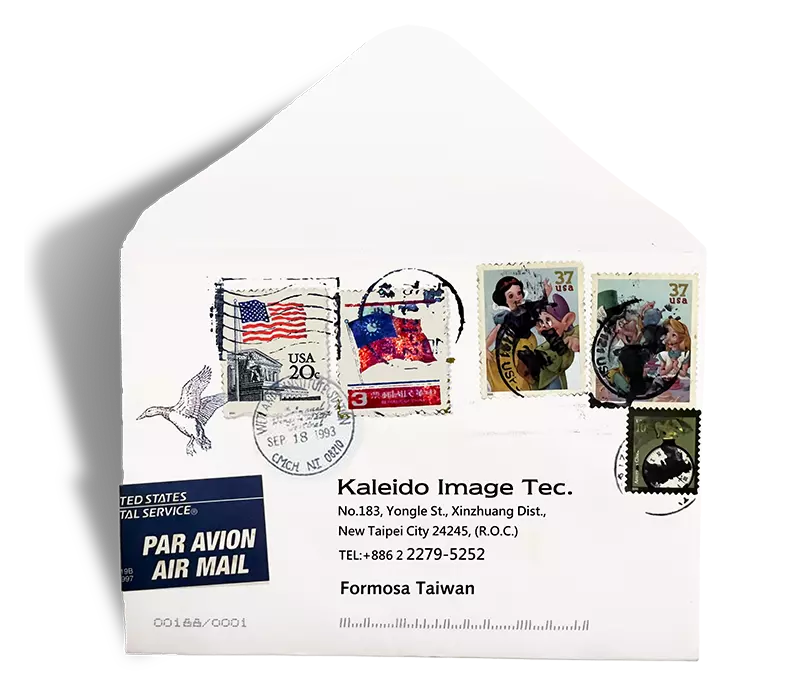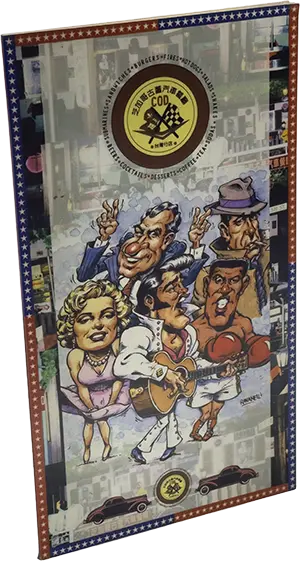
Menu Printing & OEM Production / Menu Design
Color Printing OEM: A Professional, Eco-Friendly Printing Solution
Color printing OEM is a business model that provides clients with customized color printing services, primarily utilizing water-based inkjet printers. These printers are known for their eco-friendly, non-toxic properties, making them safe for living environments. They produce rich, multi-layered translucent colors with excellent ink diffusion, resulting in near-photographic quality without visible halftone dots. As a result, this printing method is increasingly recognized and favored by clients.
Color printing OEM providers offer professional design and technical capabilities, enabling them to handle layout, design, and printing according to each client’s specific needs. Equipped with advanced printing equipment and technology, they can deliver high-quality printed materials with fast and reliable turnaround times. This allows clients to focus on their core business while safeguarding their intellectual property and commercial confidentiality.
The applications of color printing OEM are extensive, covering posters, business cards, brochures, newspapers, magazines, packaging boxes, and more. OEM vendors typically offer a variety of printing methods and material options—such as glossy paper, matte paper, single sheets, and folded formats—to accommodate different budgets and requirements. Clients can choose from various design styles and printing effects, including full-color, monochrome, and multi-color printing, as well as special finishes like embossing, foil stamping (gold or silver), and textured effects to enhance visual appeal and richness.
In summary, color printing OEM provides clients with a convenient, efficient, and high-quality printing service that enables them to concentrate on their core operations. As technology evolves and market demand grows, it’s important for buyers to note that water-based inkjet printing—due to its translucent nature—cannot achieve the same level of saturation as color laser printers or oil-based printing systems.
Formosa Taiwan

MENU second letter E
E-type binder with double-volume soft plastic inner sleeves.
Unexpected Durability
During the initial planning meetings for the opening of a tourism-themed factory store, the buyer proposed specific design criteria and usage requirements. After joint discussions and visual drafts, it was discovered that the E-style binder caused irregular alignment of the inner pages, potentially disrupting the visual presentation. To resolve this, a strip of black leather was added to decorate and stabilize the spine.
Two years later, the buyer decided to remake the menu book—this time opting for functional fabric. As of 2023, the new version remains in regular use without issue.
The term “unexpected durability” refers to the fact that the original design was only intended to last for six months before replacement. Yet, it ended up being used for two full years. And now, the project is being revived once again—two years later.
Material:
Paper
Processing:
Diamond lamination
Binding:
Screw binding with leather-accented spine decoration
Inner pages:
Double-thickness glossy / matte soft plastic sleeves for inner pages
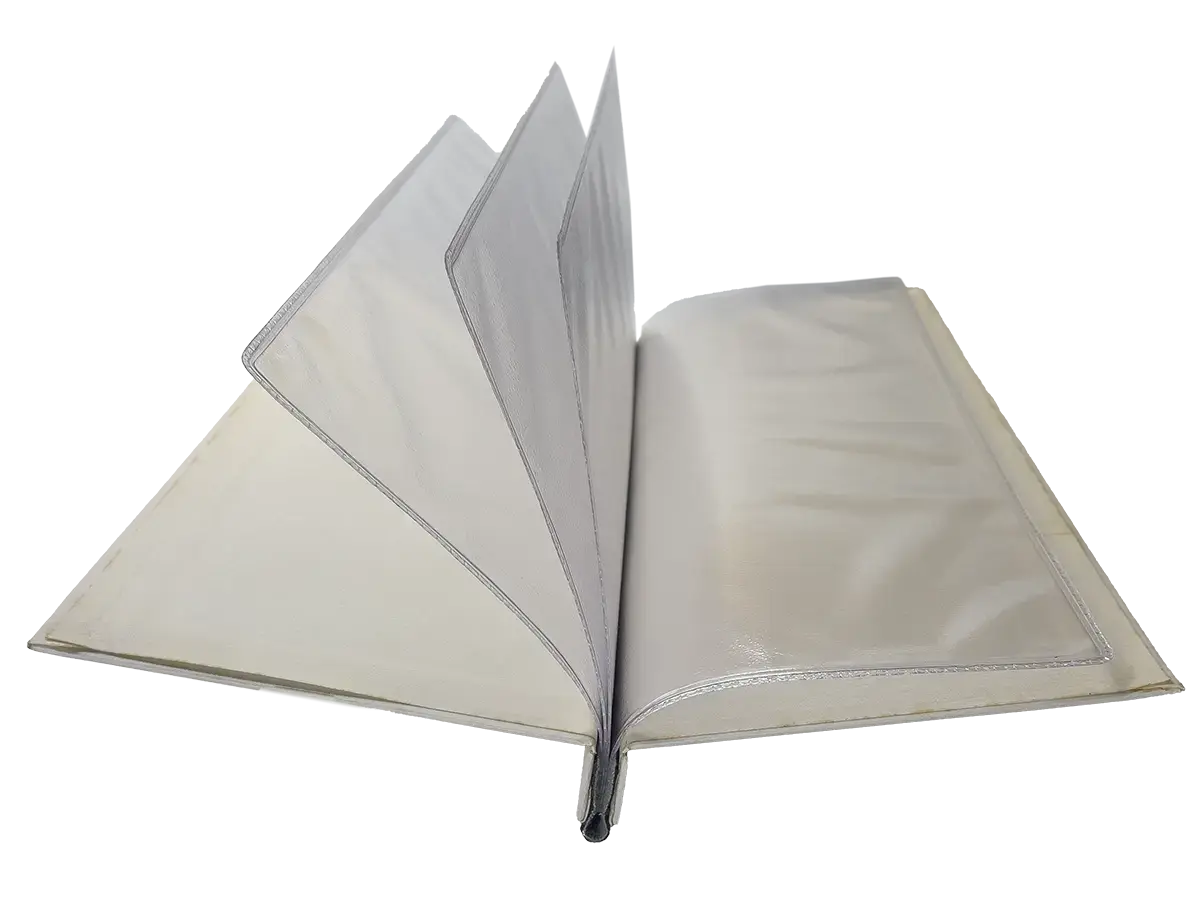
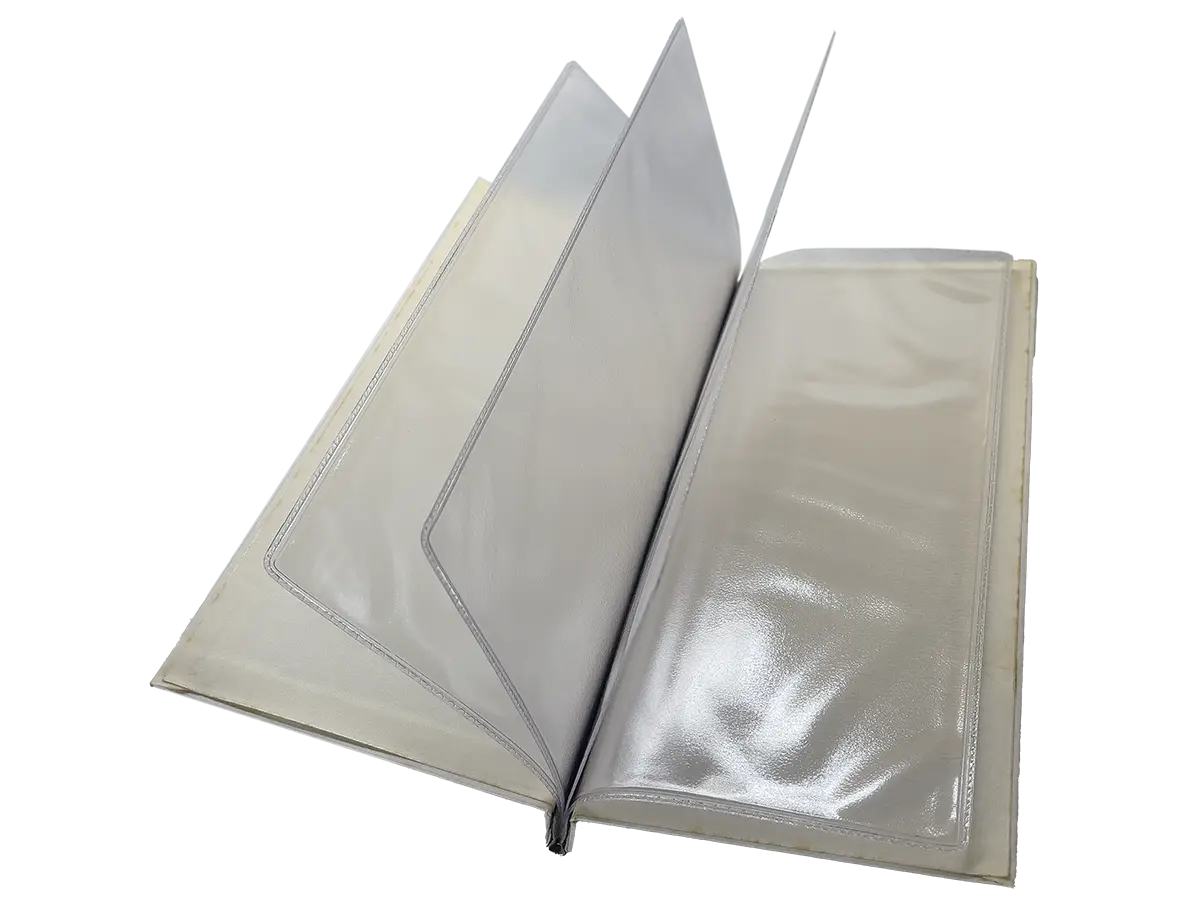
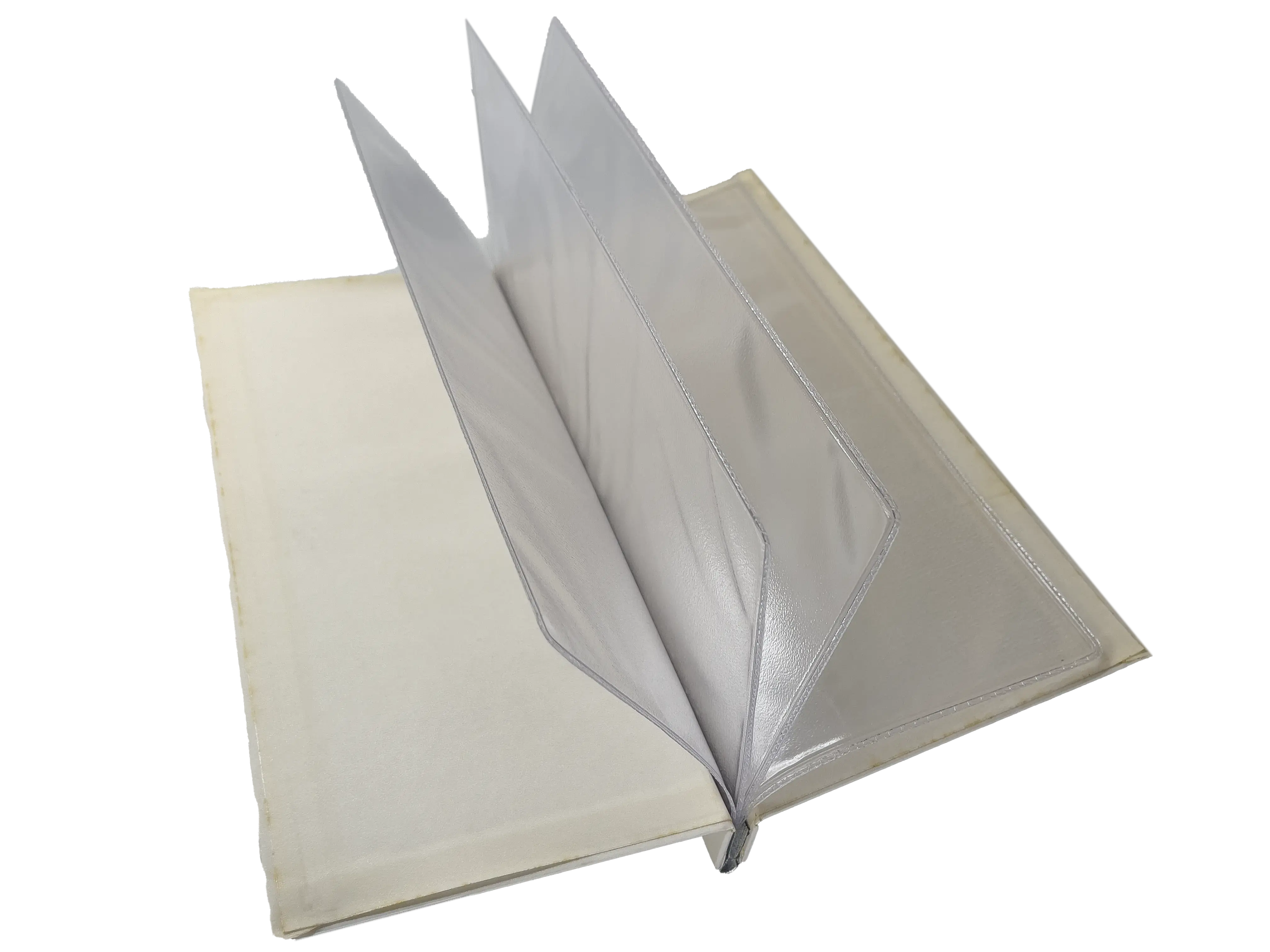
We’ve successfully developed the sixth generation of our inner sleeve system, offering the industry’s most diverse selection of five formats to meet a wide range of needs. Clients can choose between glossy or matte finishes to suit their aesthetic and functional preferences.
This innovative product design, paired with impeccable craftsmanship, further strengthens our leadership in the field. Whether you’re pursuing culinary excellence or seeking the finest in menu presentation, we deliver the perfect product solution—tailored to elevate every experience.
Reference Number:iPrint1
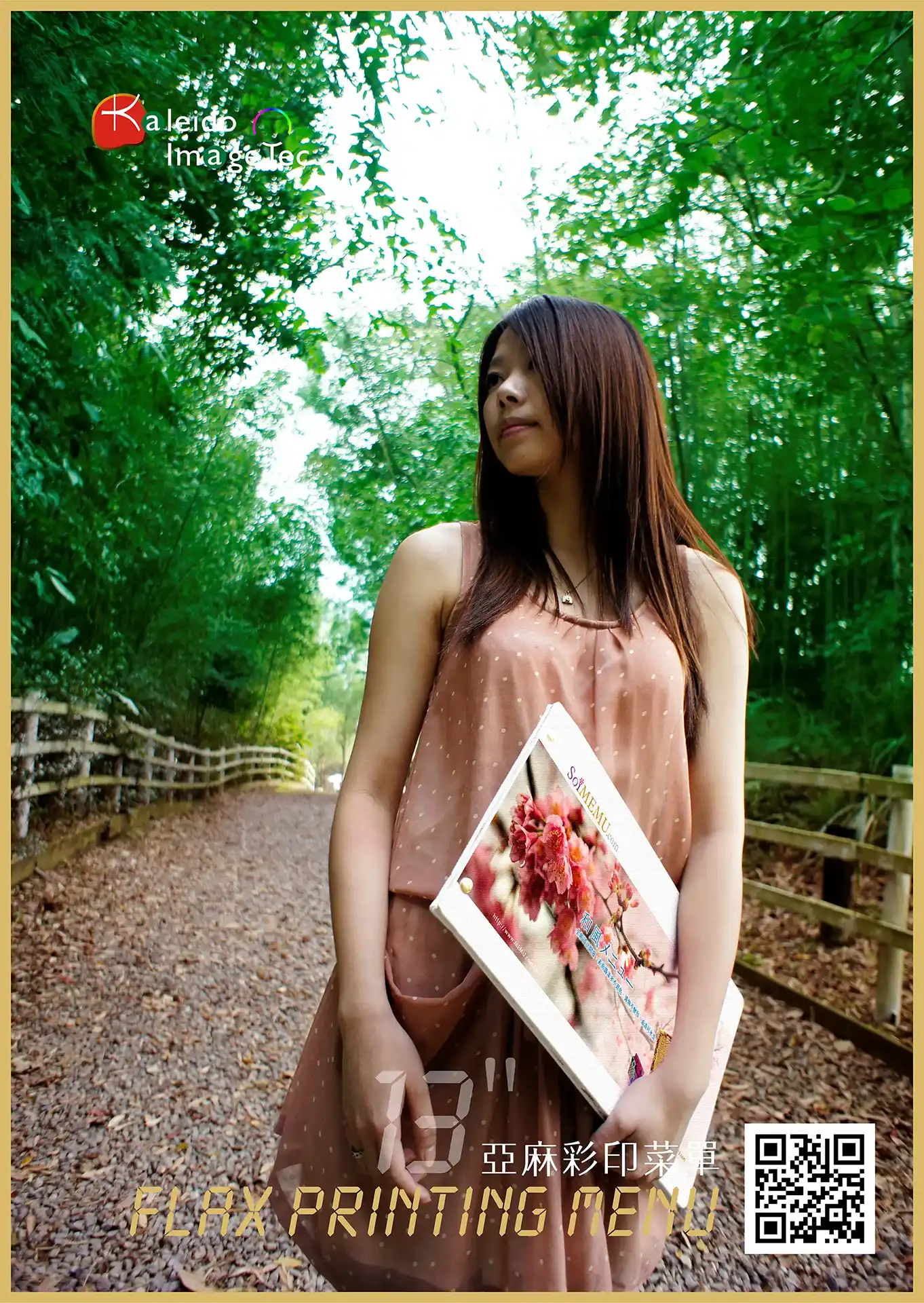
MENU fourth letter U
U-bar document case equipped with double-thickness 180 lb ivory paper inserts
Bar Binding: A Practical and Quick Option
Bar binding is one of the most practical and efficient choices for loose-leaf binding. It’s the simplest method, requiring no technical expertise. For example, using 180 lb ivory paper, a bar binder can typically hold around 1 to 10 sheets. With 70 lb standard copy paper (such as those found in convenience stores), it can accommodate approximately 1 to 40 sheets.
Material:
Paper
Processing:
Diamond lamination
Binding:
Binding bar / Plastic binding spine
Inner pages:
Double-thickness 180 lb ivory paper
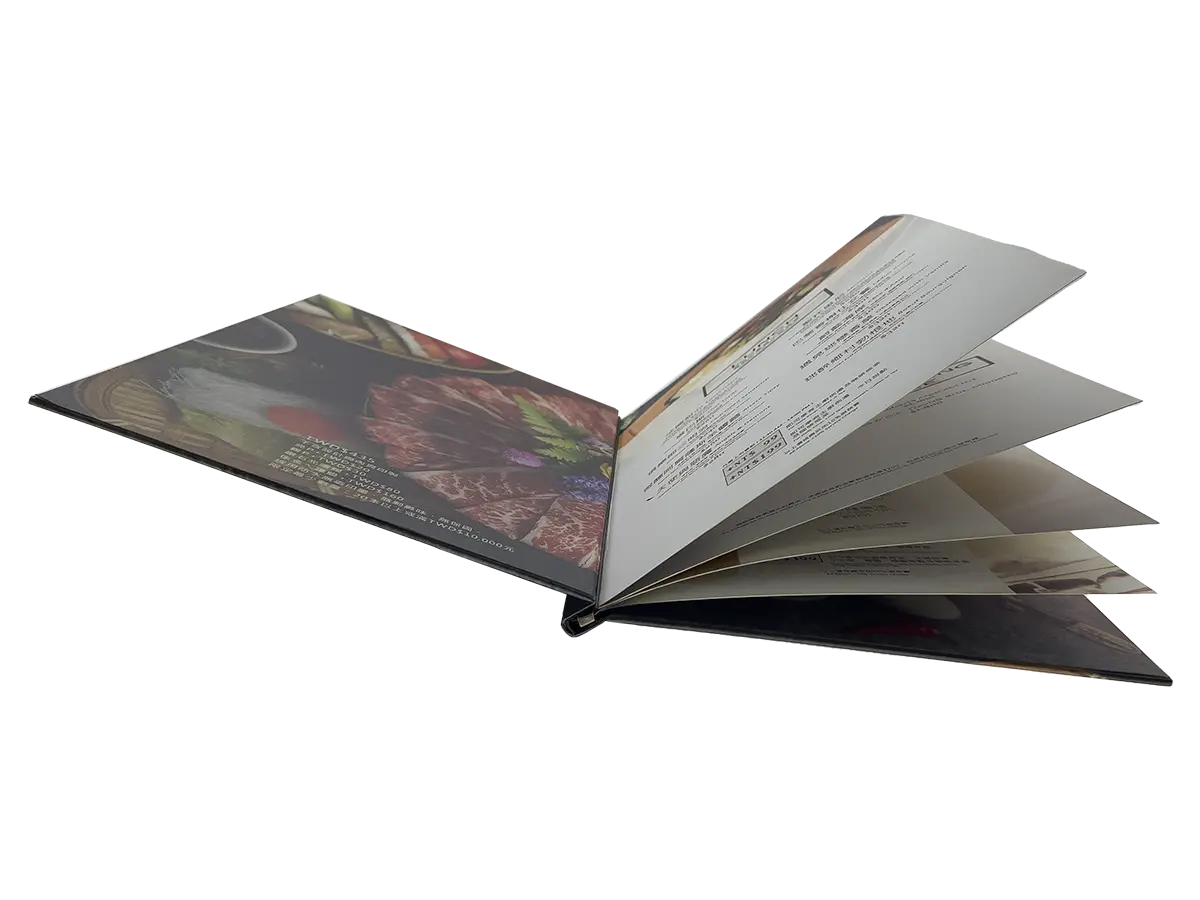
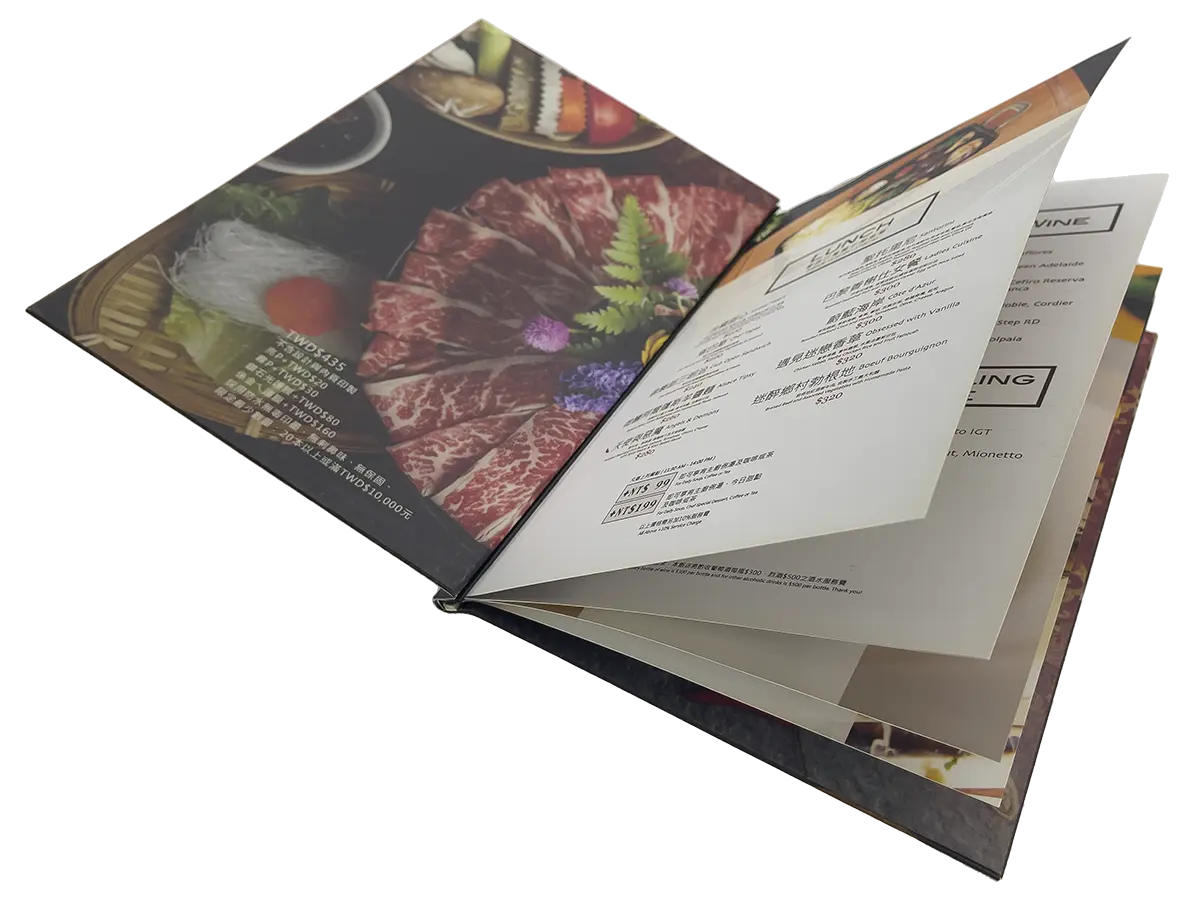
The 180 lb double-coated paper inserts are finished with a matte P-film lamination. The water-based ink used for printing is non-toxic and odorless, compliant with food safety and environmental standards. Compared to oil-based inks, it delivers more vibrant colors.
To support a healthier living and working environment, we recommend choosing water-based ink for full-color printing. This version features double-thickness 180 lb inserts, printed with water-based ink and bound using a black bar binder.
Reference Number:iPrint2
MENU fourth letter U
U-style binder box with E-style mimic design, equipped with double-thickness 180 lb ivory paper inserts
Since the E-style binder exposes the side-bound inner pages, this binding method may result in irregular alignment or visual inconsistencies. As shown in Figure 1, a decorative spine element can be added to conceal and refine the appearance. Alternatively, a U-style binder mimicking the E-style format may be used to achieve a similar aesthetic with improved structural consistency.
Material:
Paper
Processing:
Matte P-film / Glossy P-film
Binding:
hemp rope
Inner pages:
Double-thickness 180 lb ivory paper
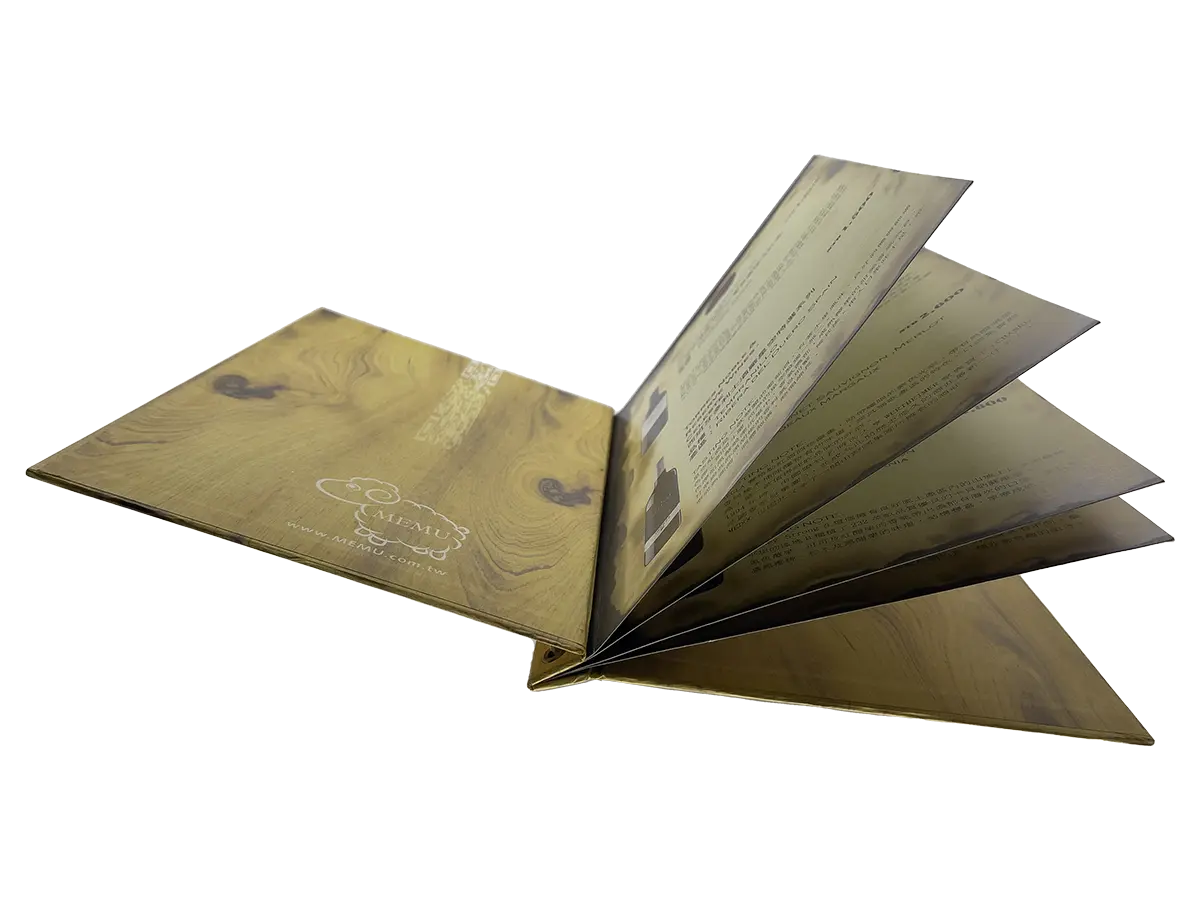
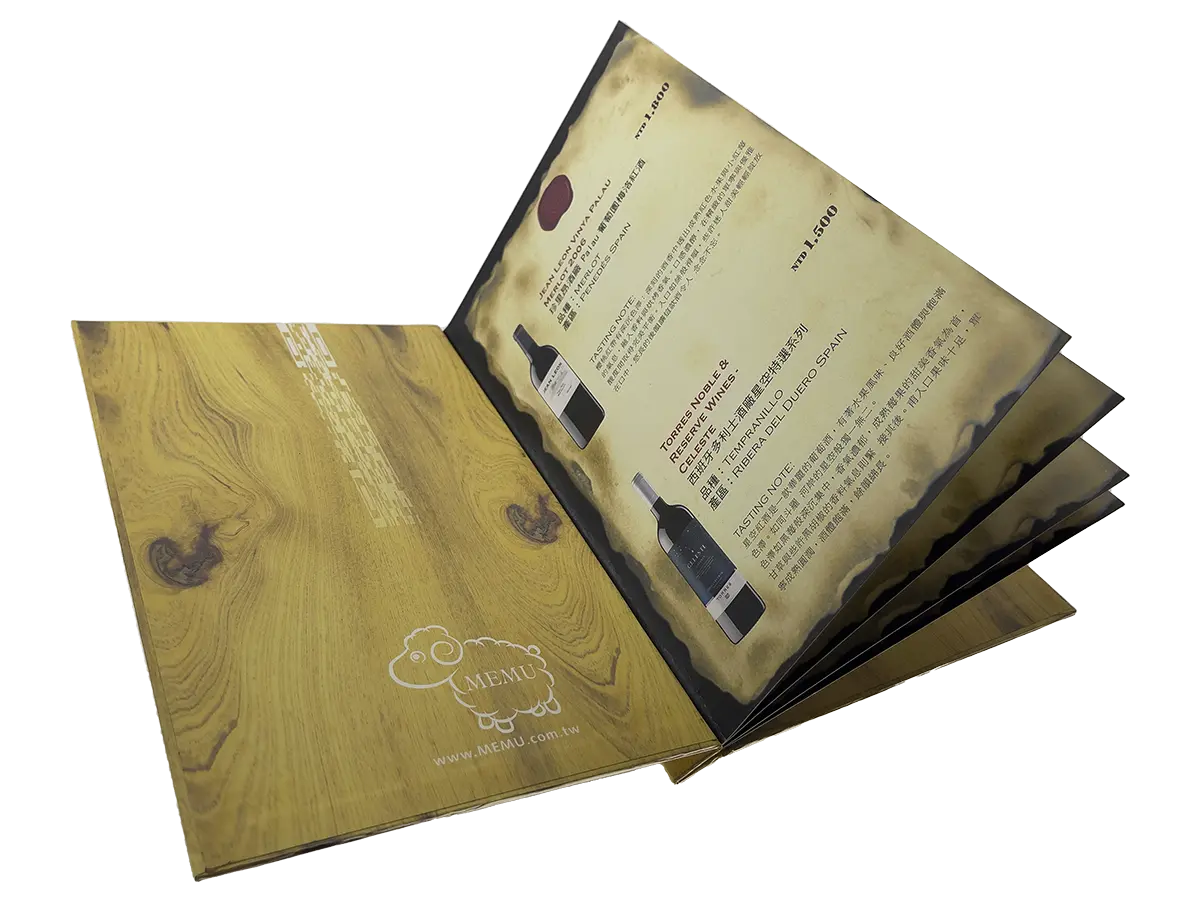
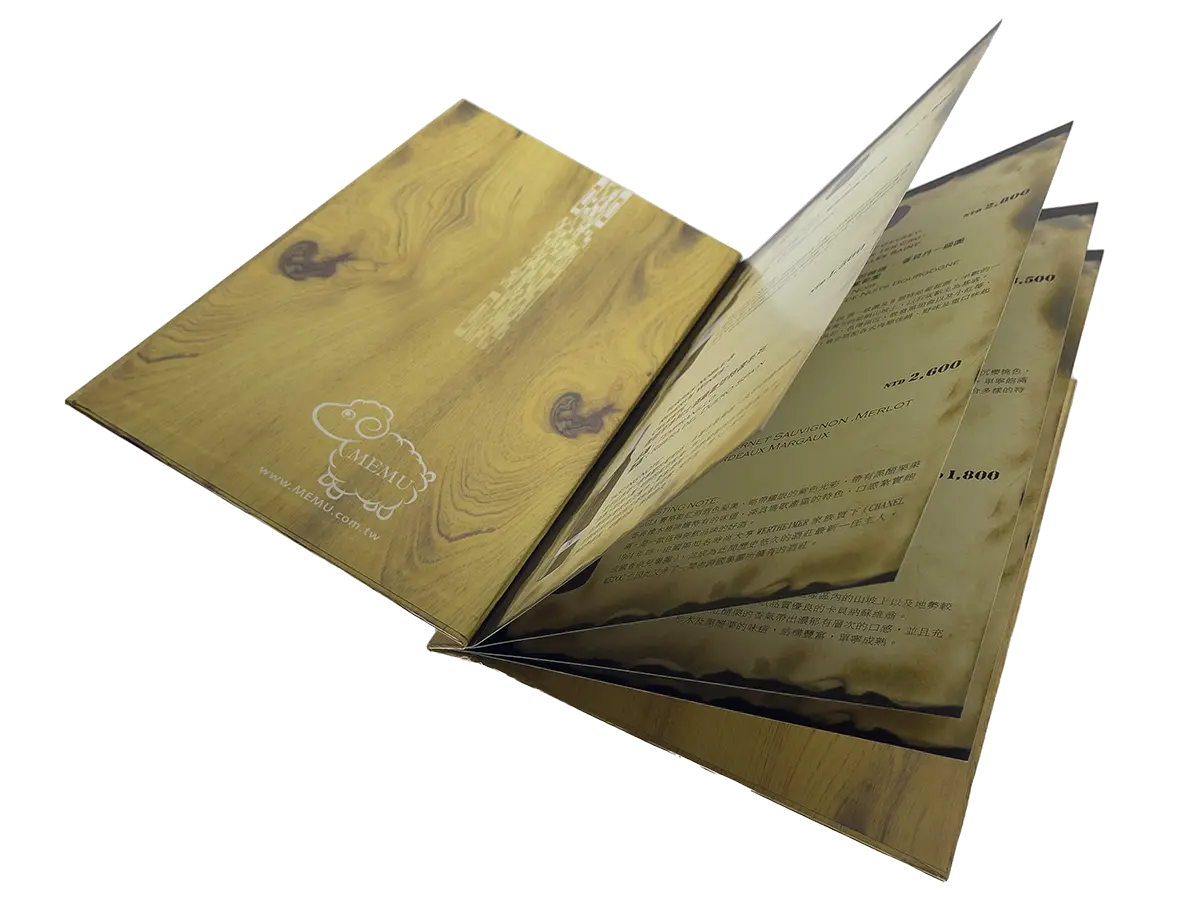
The 180 lb double-coated paper inserts are finished with a matte P-film lamination. The water-based ink used for printing is non-toxic and odorless, meeting food safety and environmental standards. Compared to oil-based inks, it delivers more vivid and vibrant colors.
To support a healthier living environment, we recommend choosing water-based ink for full-color printed inserts. This version features double-thickness 180 lb paper, printed with water-based ink and bound using perforated holes and natural twine for loose-leaf binding.
Reference Number:iPrint3
MENU fourth letter U
U-bound adhesive case with fixed binding, featuring quadruple-thickness 180 lb ivory paper inserts (non-loose-leaf binding)
- Back in our founding days, we took on orders from Ximending, Taipei—armed only with a beginner’s grasp of graphic design and printing basics.
- Our journey began in the bustling streets of Ximending, Taipei, where early orders were fulfilled with nothing more than an introductory understanding of design and print.
Material:
Paper
Processing:
Matte P-film / Glossy P-film
Binding:
Perfect binding
Inner pages:
Quad-thickness 180 lb ivory paper
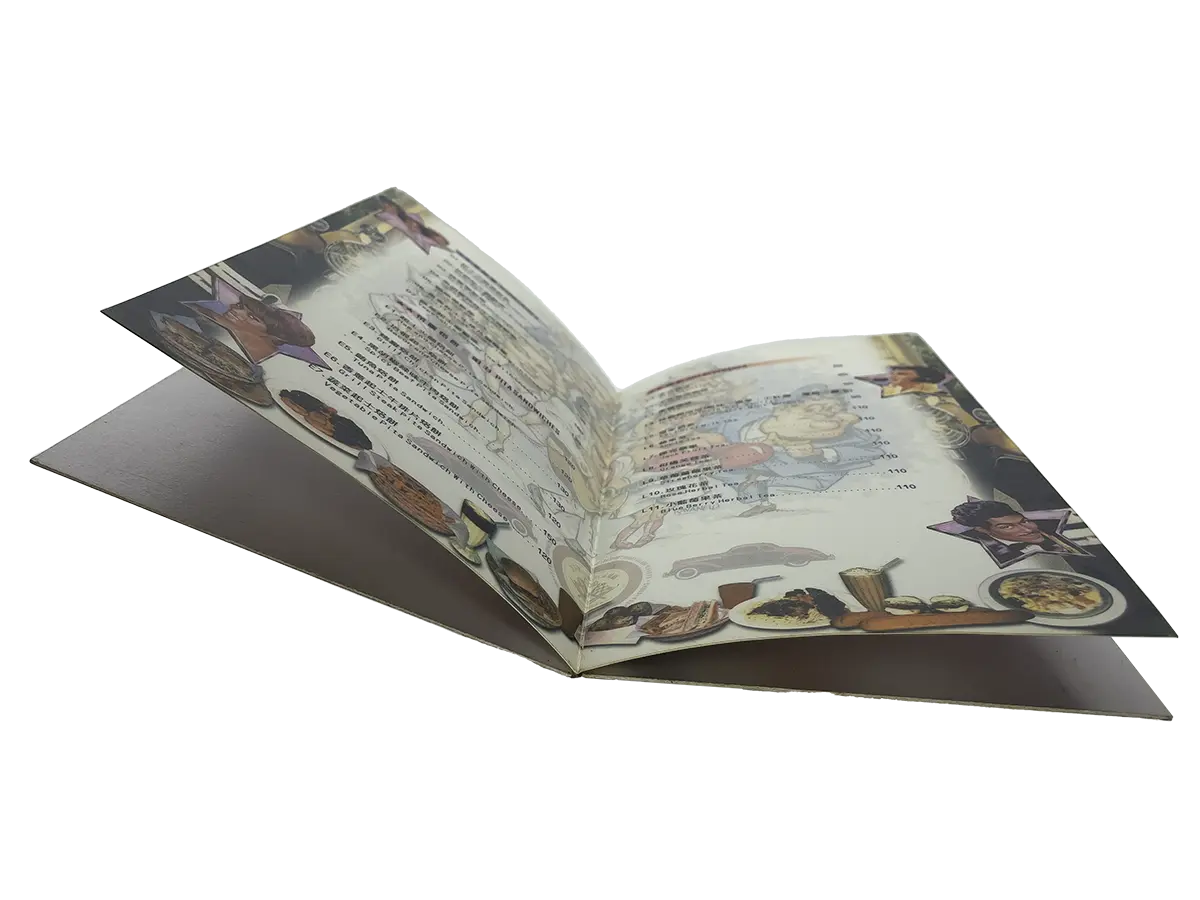
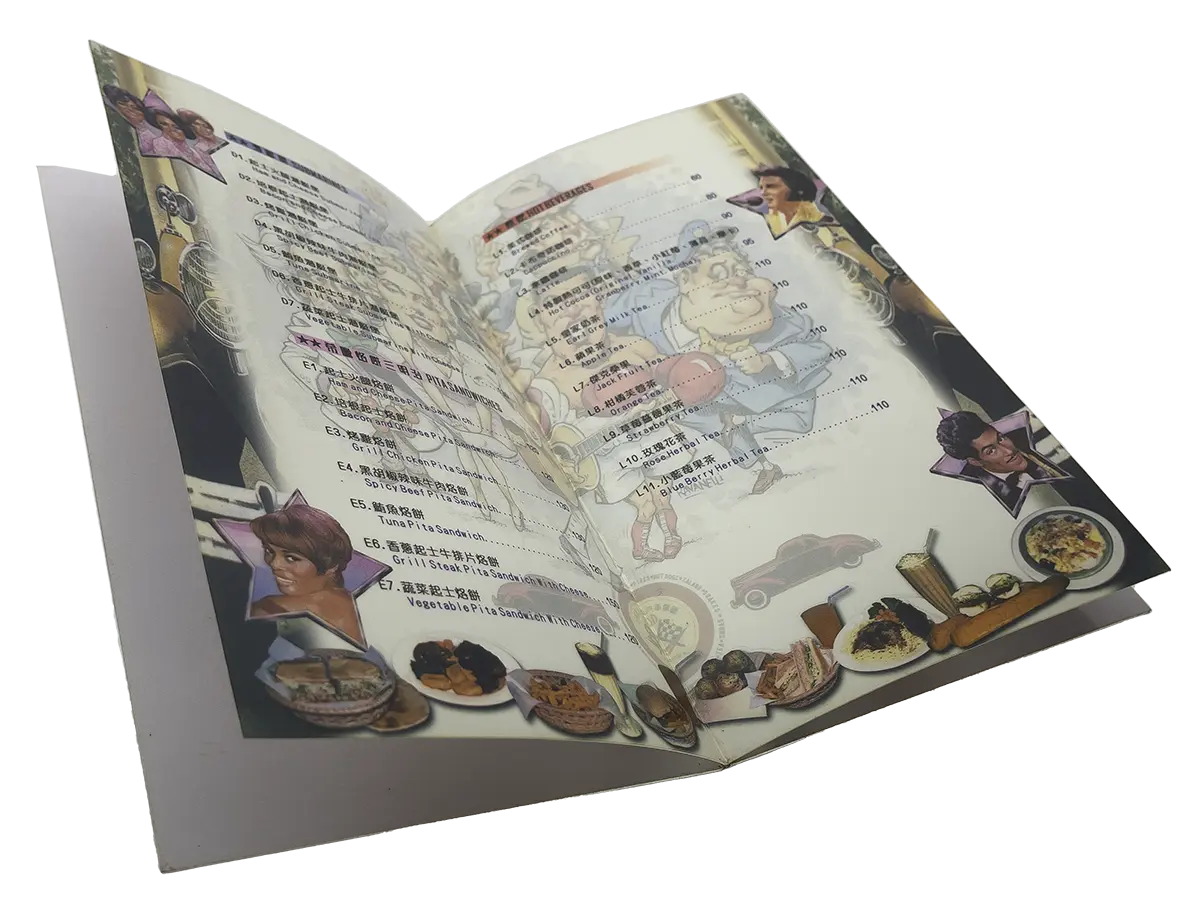
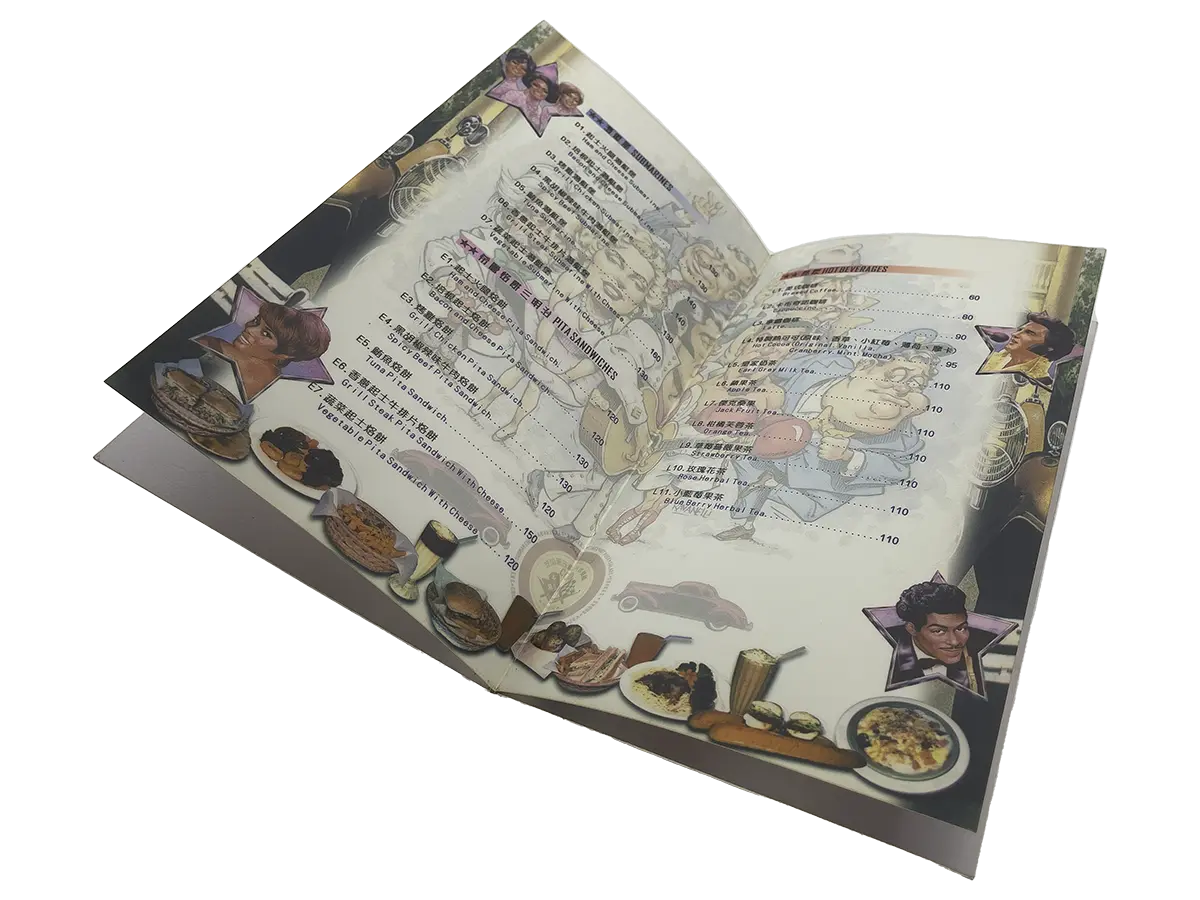
The 180 lb double-coated paper inserts are finished with a matte P-film lamination. The water-based ink used for printing is non-toxic and odorless, meeting food safety and environmental standards. Compared to oil-based inks, it delivers more vivid and vibrant colors.
To support a healthier living environment, we recommend choosing water-based ink for full-color printed inserts. This version features quadruple-thickness 180 lb paper, printed with water-based ink and bound using adhesive binding for a fixed-page format (non-loose-leaf, non-expandable).
Thanks to the substantial thickness, the pages turn smoothly without the need for additional K-line creasing or soft die-cutting.
Reference Number:iPrint4
MENU fourth letter U
U-style binder case equipped with quadruple-thickness glossy/matte soft plastic sleeves
Paper edges are prone to splitting, but edge-wrapped flat-stitched corner reinforcement effectively prevents this issue and significantly extends the paper’s lifespan. Compatible with glossy or matte soft plastic sleeves for added protection and presentation.
Material:
Paper
Processing:
Diamond lamination
Binding:
Flat cord with edge-bound stitched corner reinforcement
Inner pages:
Quad-thickness glossy / matte soft plastic sleeves for inner pages
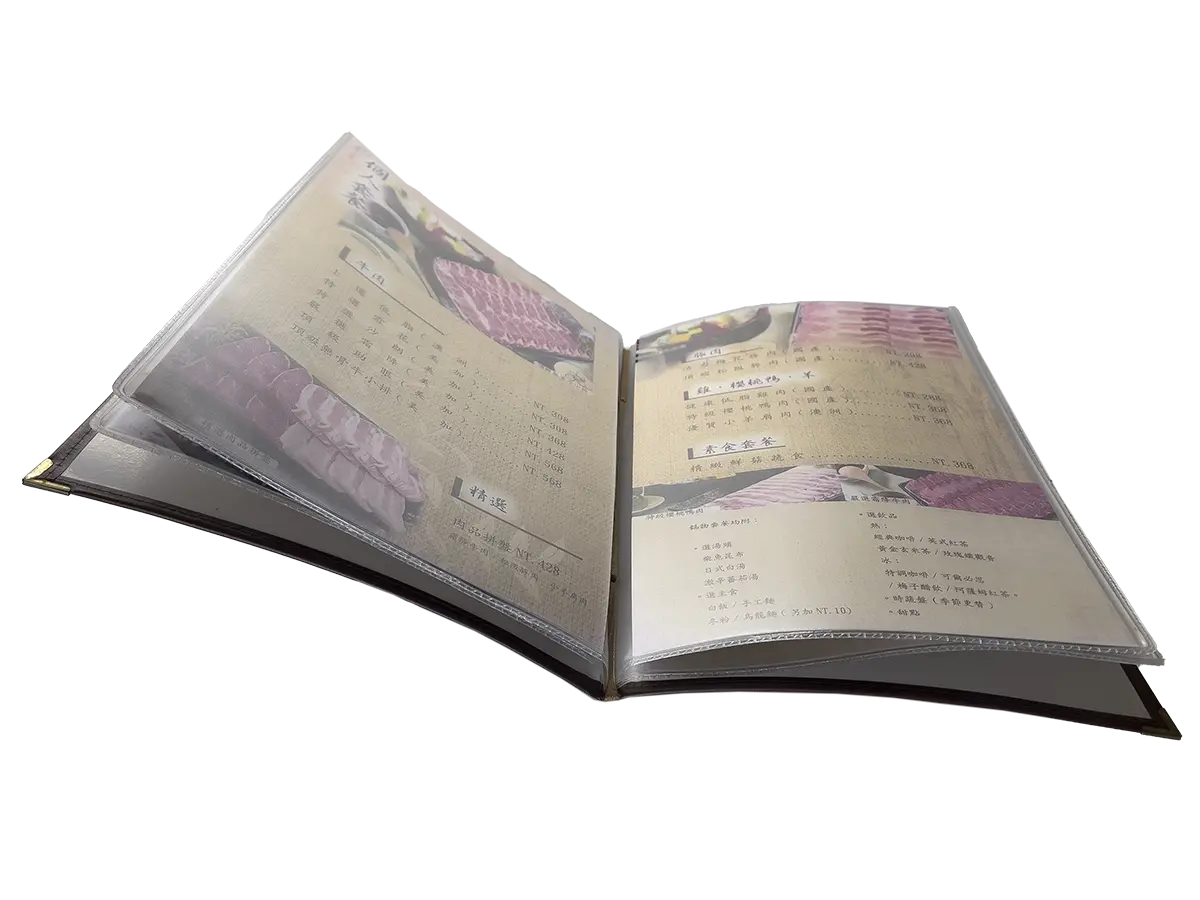
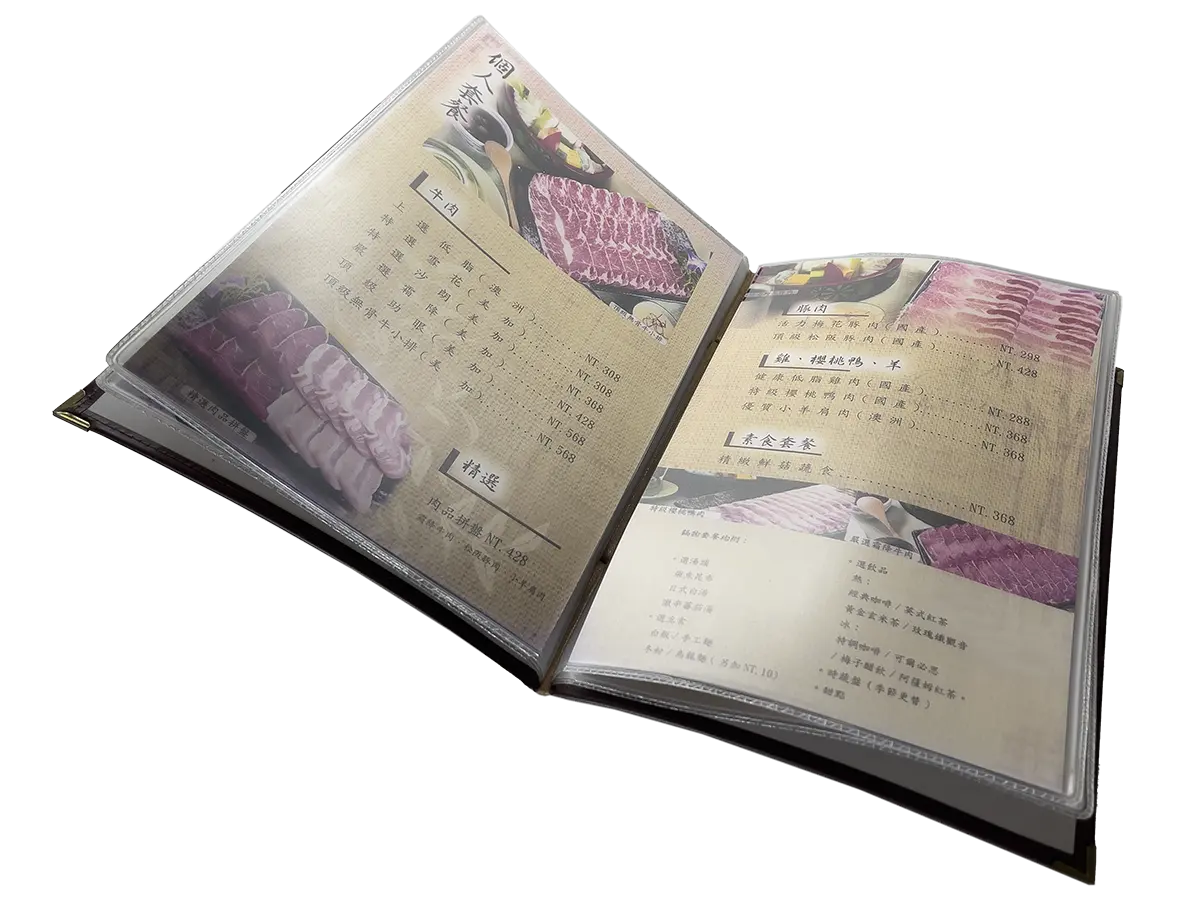
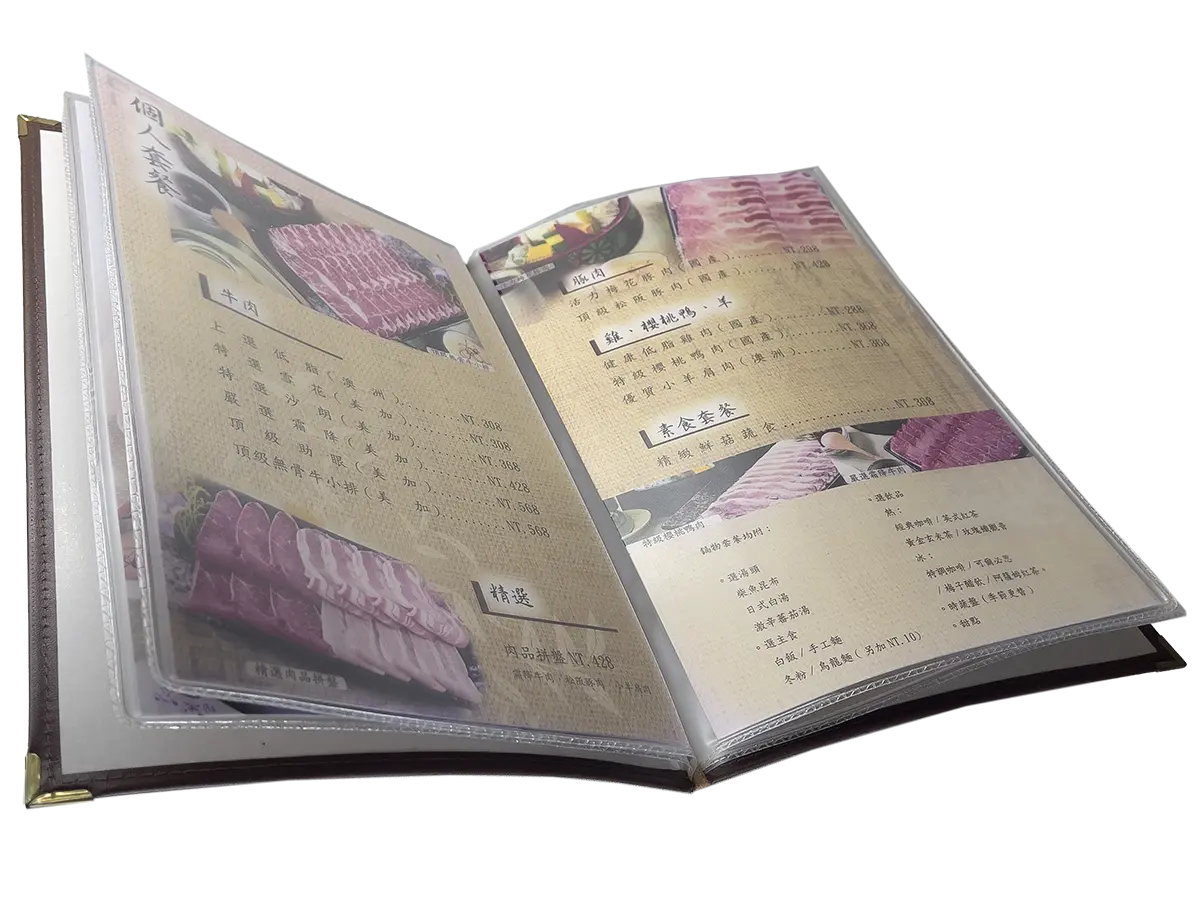
Paper has limited structural strength, so we do not recommend prioritizing the convenience of loose-leaf binding at the expense of durability. Overloading the inner pages may cause the entire book to tear or collapse.
Reference Number:iPrint5
MENU fourth letter U
U-fold four-panel layout with non-expandable binding
- Where paper tends to fray, we reinforce. Flat-stitched edge binding and corner protection preserve integrity over time, extending the life of every page.
- To prevent edge splitting, we apply flat-stitch corner reinforcement—a quiet but powerful solution that keeps each sheet intact, longer.
Material:
Paper
Processing:
Diamond lamination
Binding:
Edge-bound straight-stitched corner reinforcement
Inner pages:
none
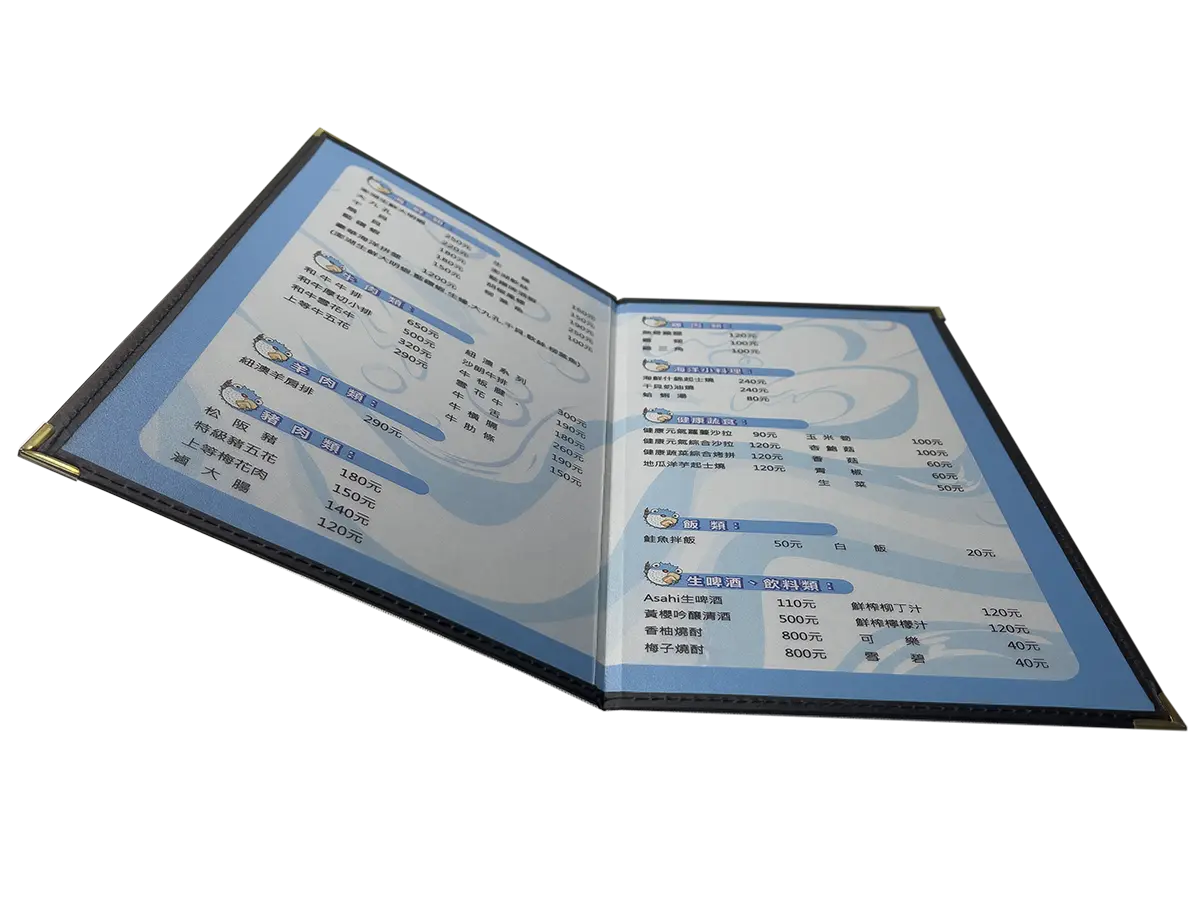
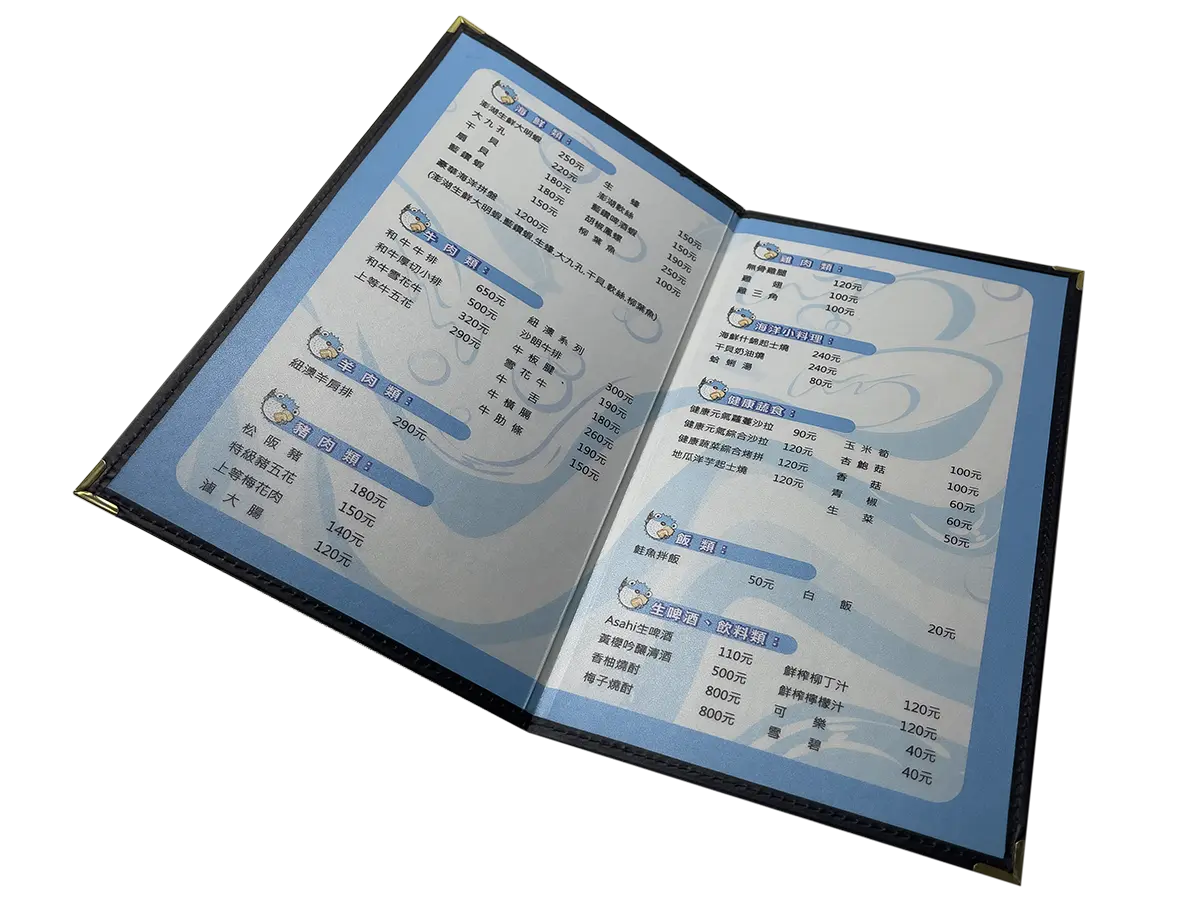
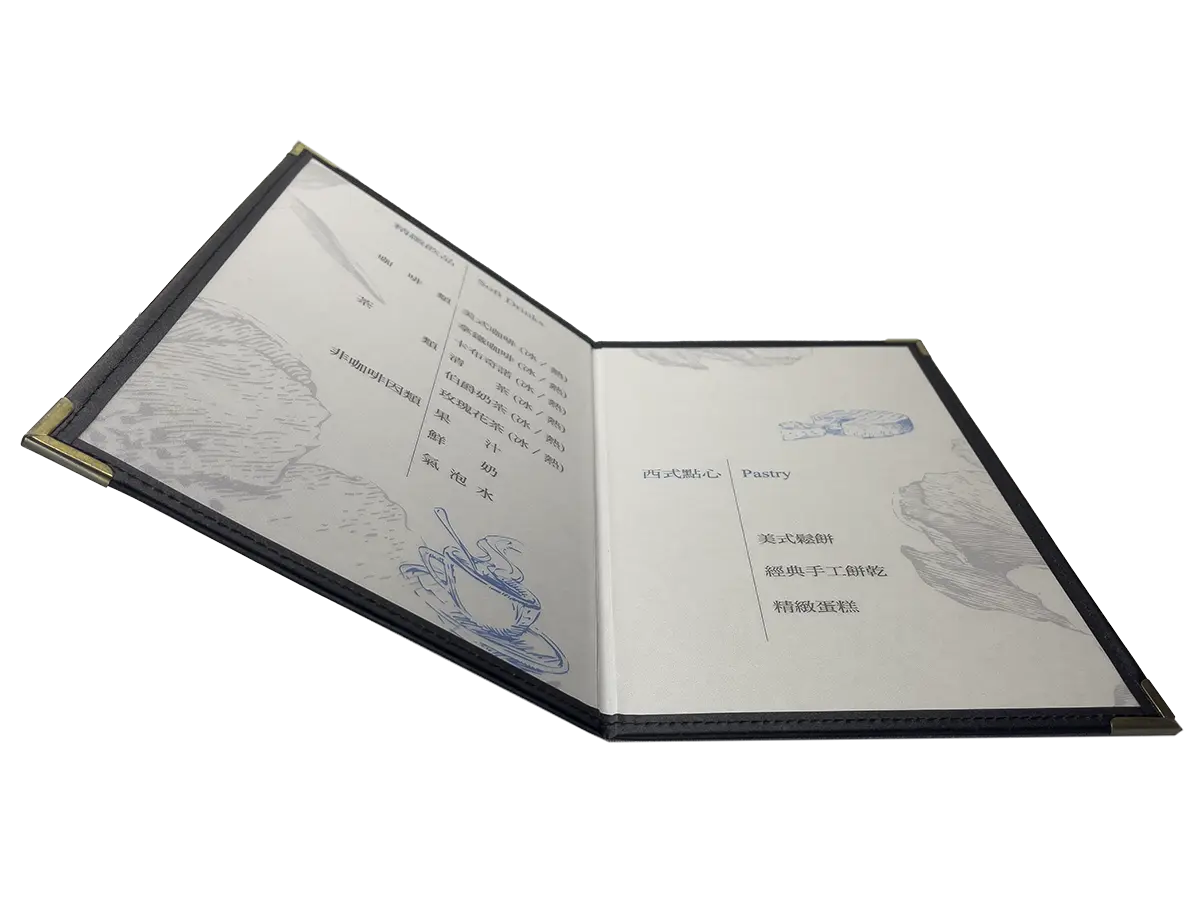
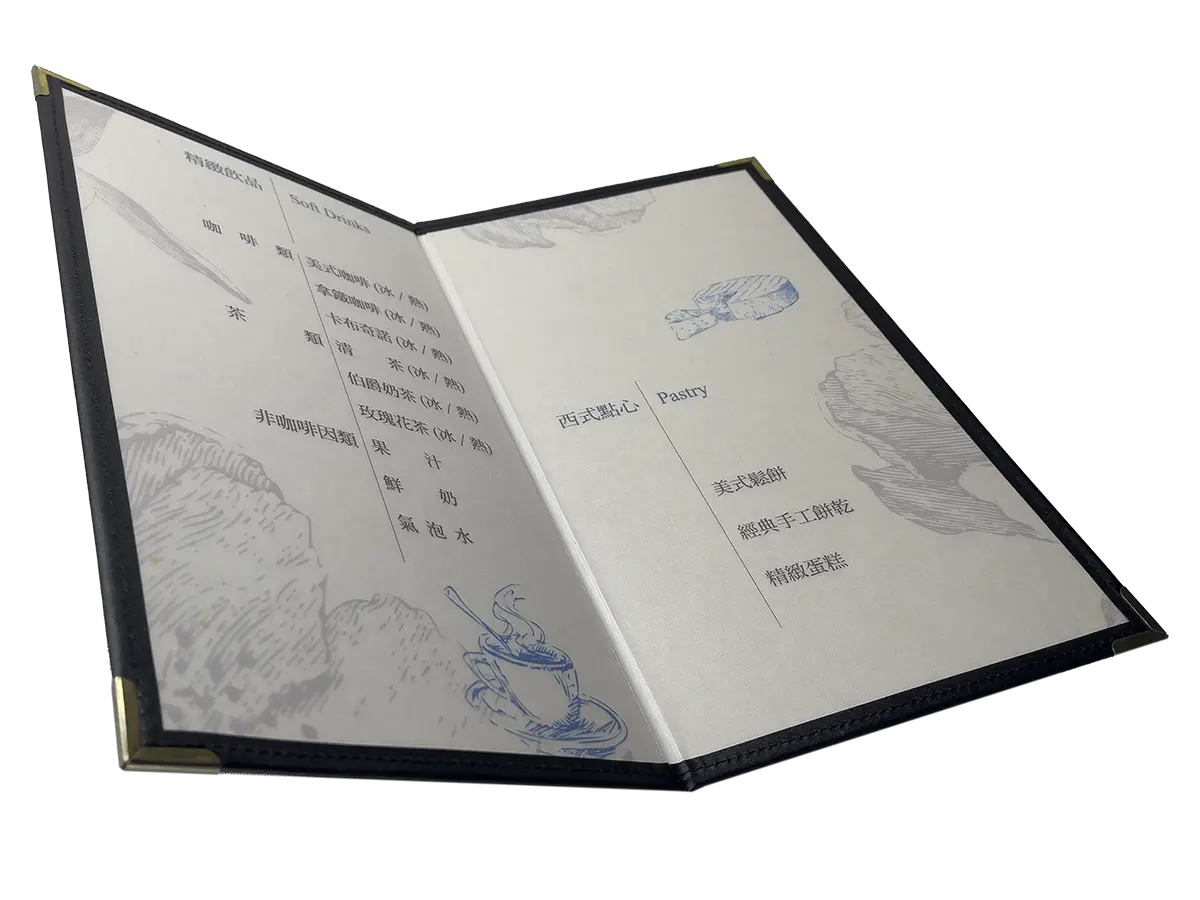
Non-expandable and cost-effective, this option is ideal for small-scale operations seeking a balance between practicality and durability.
Reference Number:iPrint6
MENU fourth letter U
U-fold four-panel format with non-expandable binding
Protective lamination finishes for color prints
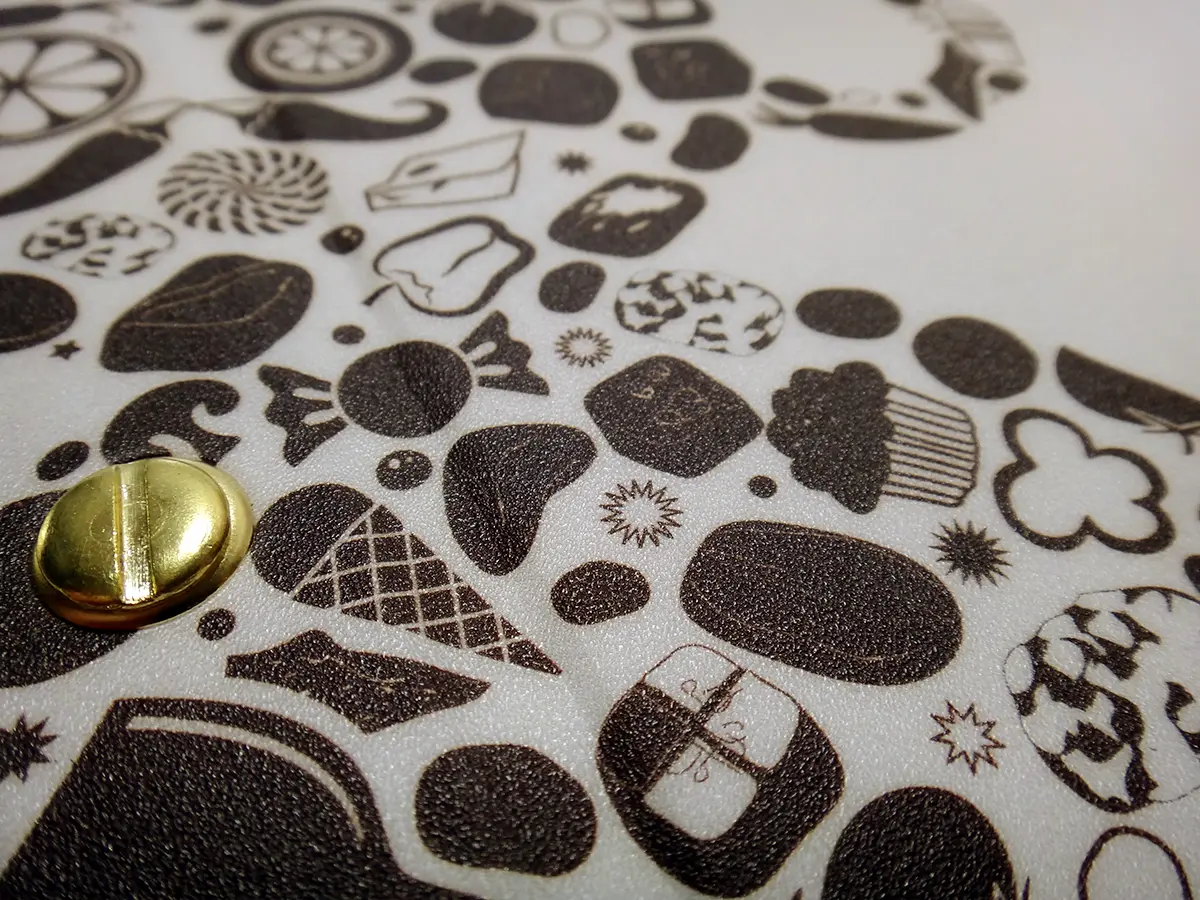
Diamond lamination
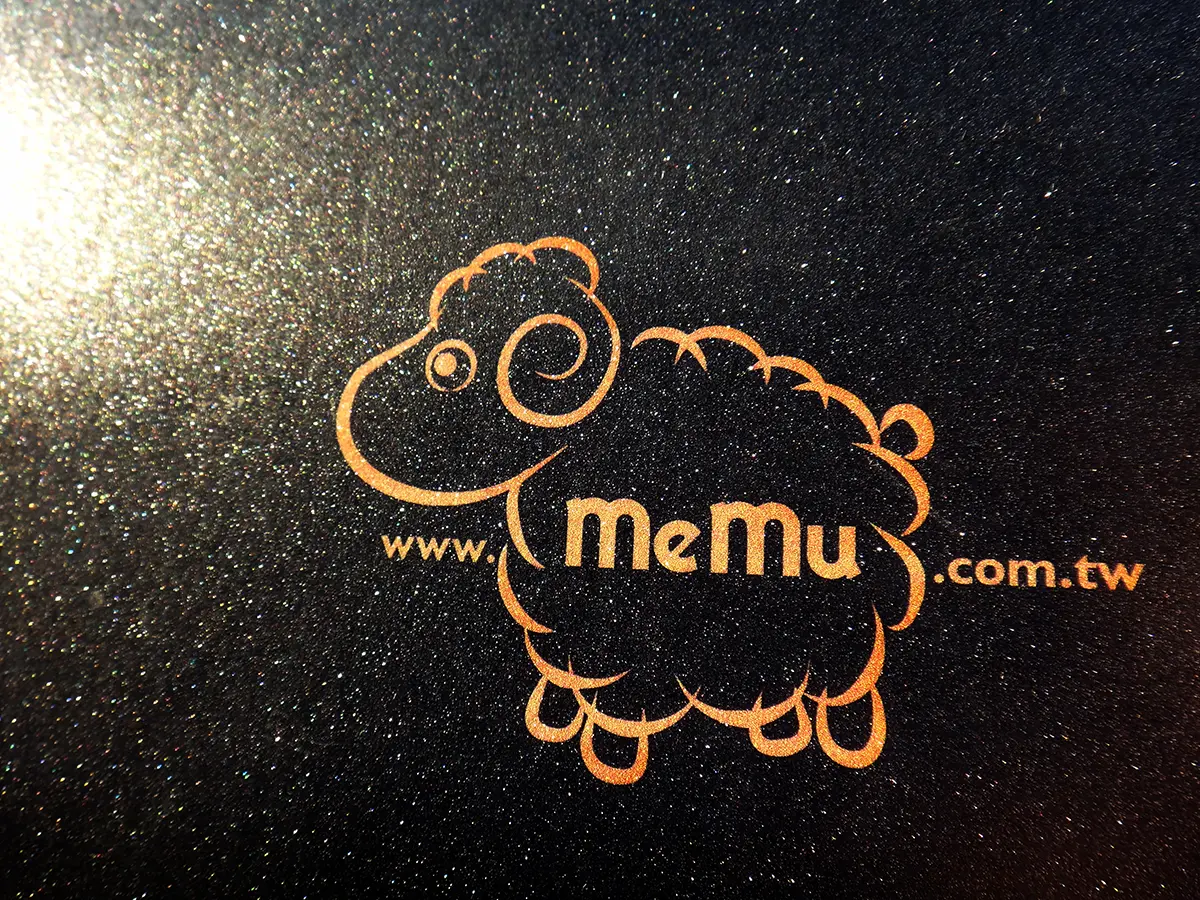
Premium-grade lamination
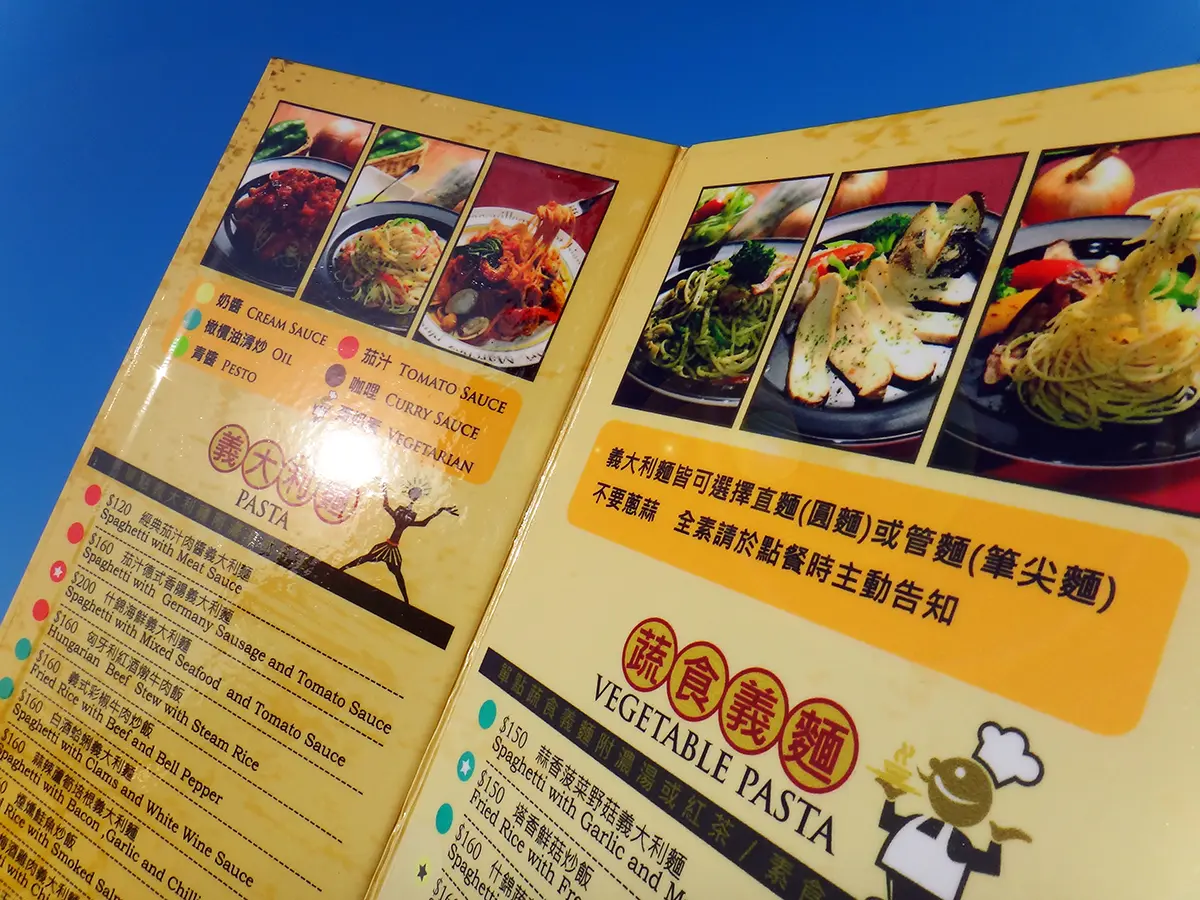
Glossy P-film lamination is commonly used in standard printing.
Is a similar event happening now
Strategies to stop the occurrence of a vicious cycle
It is advisable to replace it as soon as possible with SGS-certified materials for better safety and precaution
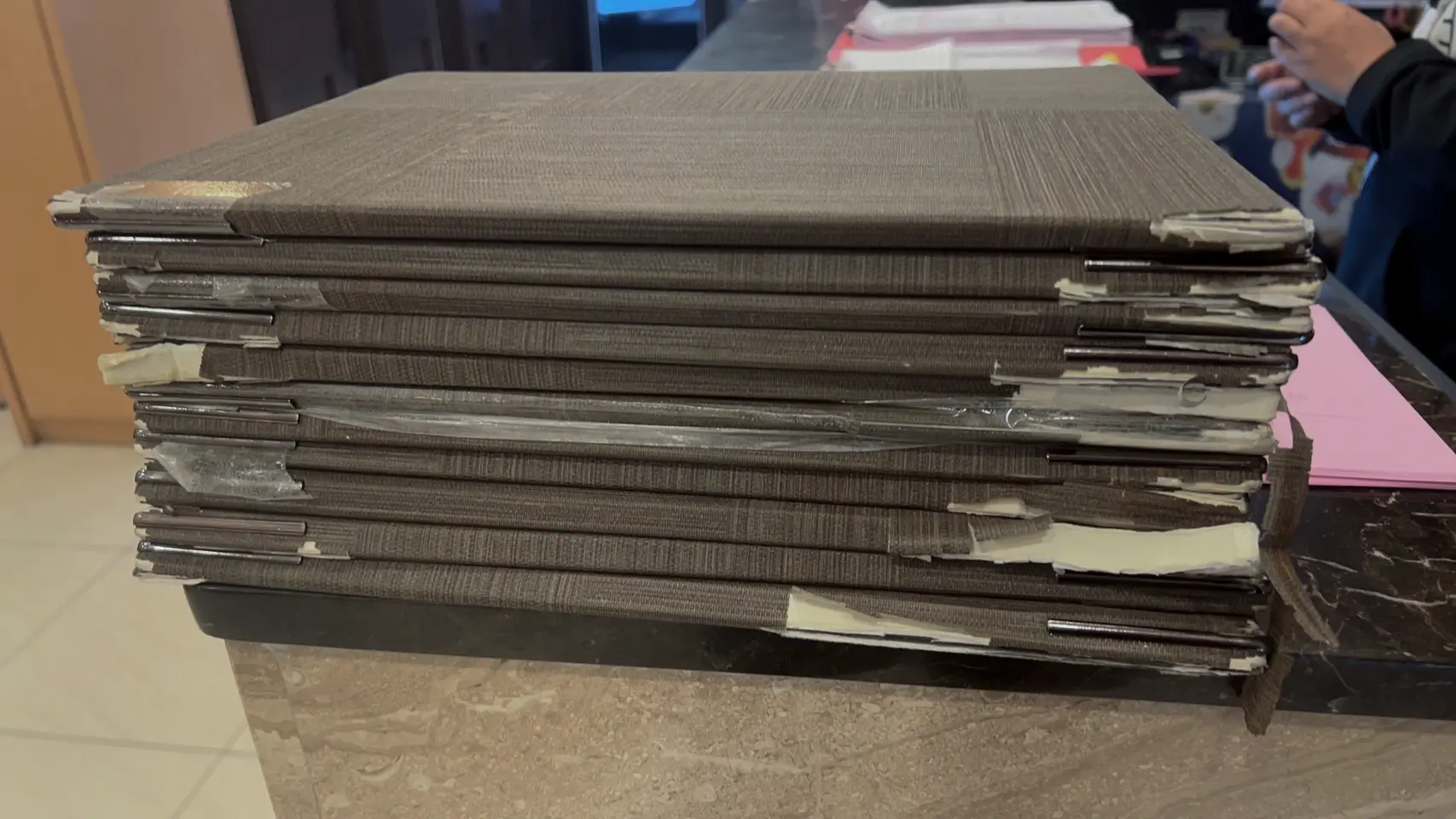
The paper-mâché fake menu shown in the picture is severely damaged, which has significantly affected operations and the dining experience of food enthusiasts. It also poses a serious health threat to individuals with allergies.
Seemingly harmless and widely circulated: fake menu books.
These fake menus attract buyers with their exquisite appearance and low prices, but they conceal unknown risks. Customers have reported that the menus they purchased, which appeared to be made of fabric, were actually counterfeit items using paper packaging materials with leather or fabric-like textures. This type of paper packaging is unsuitable for use in the food service industry as it is prone to damage and oil absorption, potentially deteriorating within 2 to 4 weeks. Long-term use carries risks of mold growth and oil absorption, posing serious health threats to individuals with allergies. Additionally, this impacts the operations of businesses and the dining experience of food enthusiasts, creating a vicious cycle of repeated investments. It is recommended that buyers use materials verified by SGS to meet hygiene and safety standards, ensuring the restaurant’s operation and the customers’ dining experience. This will enhance customer trust and promote long-term business growth.
Features and Warranty
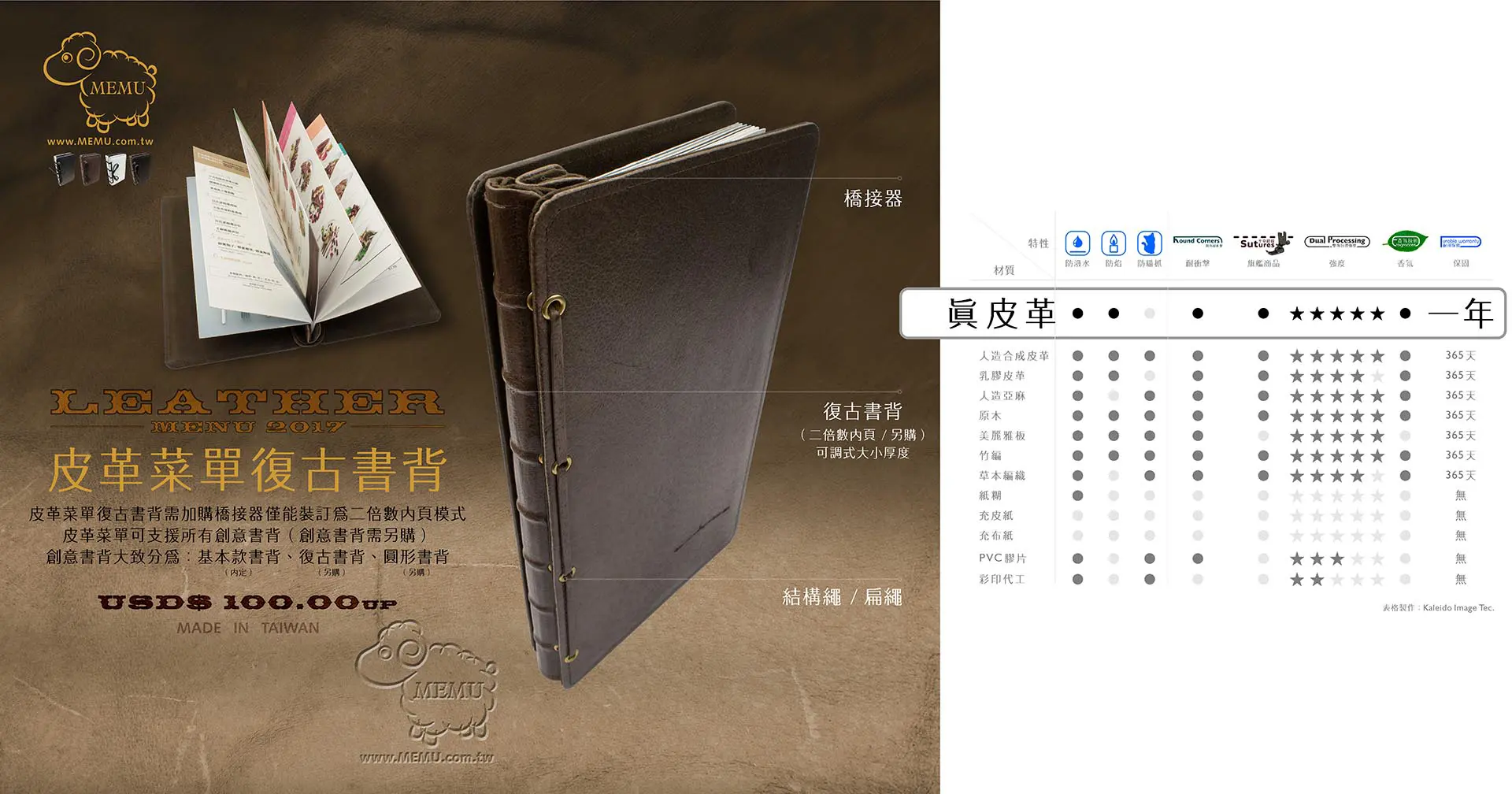
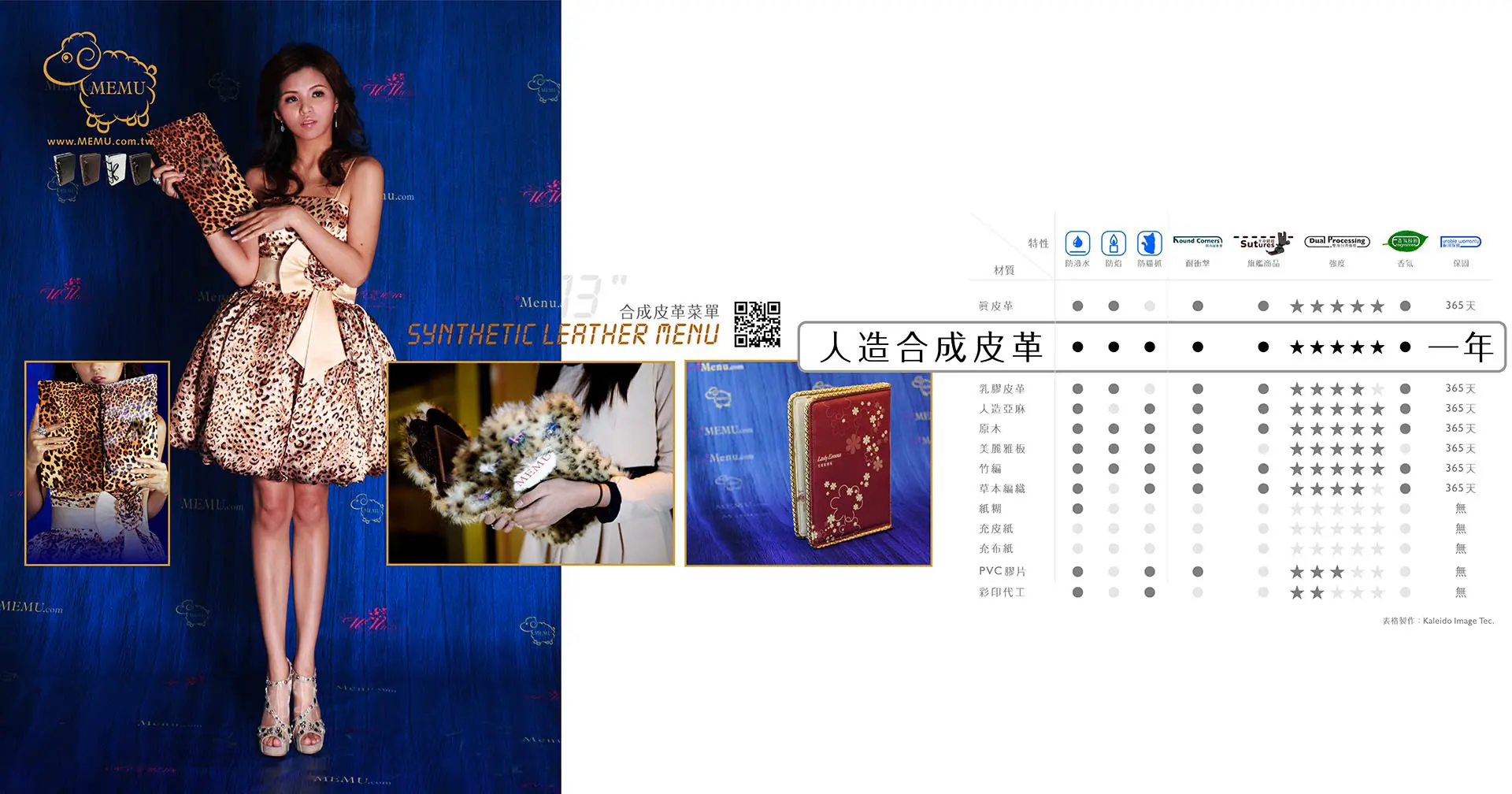
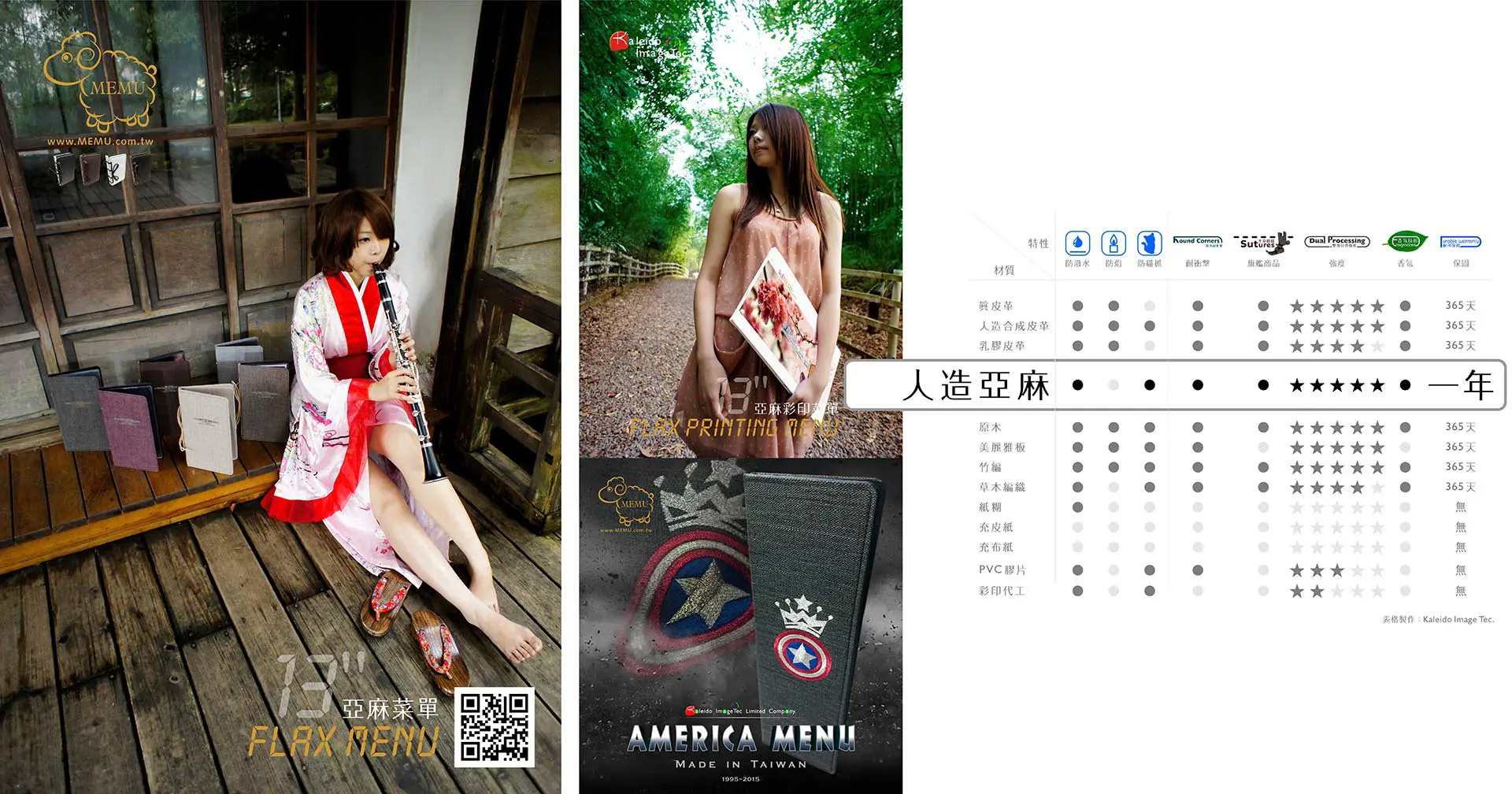
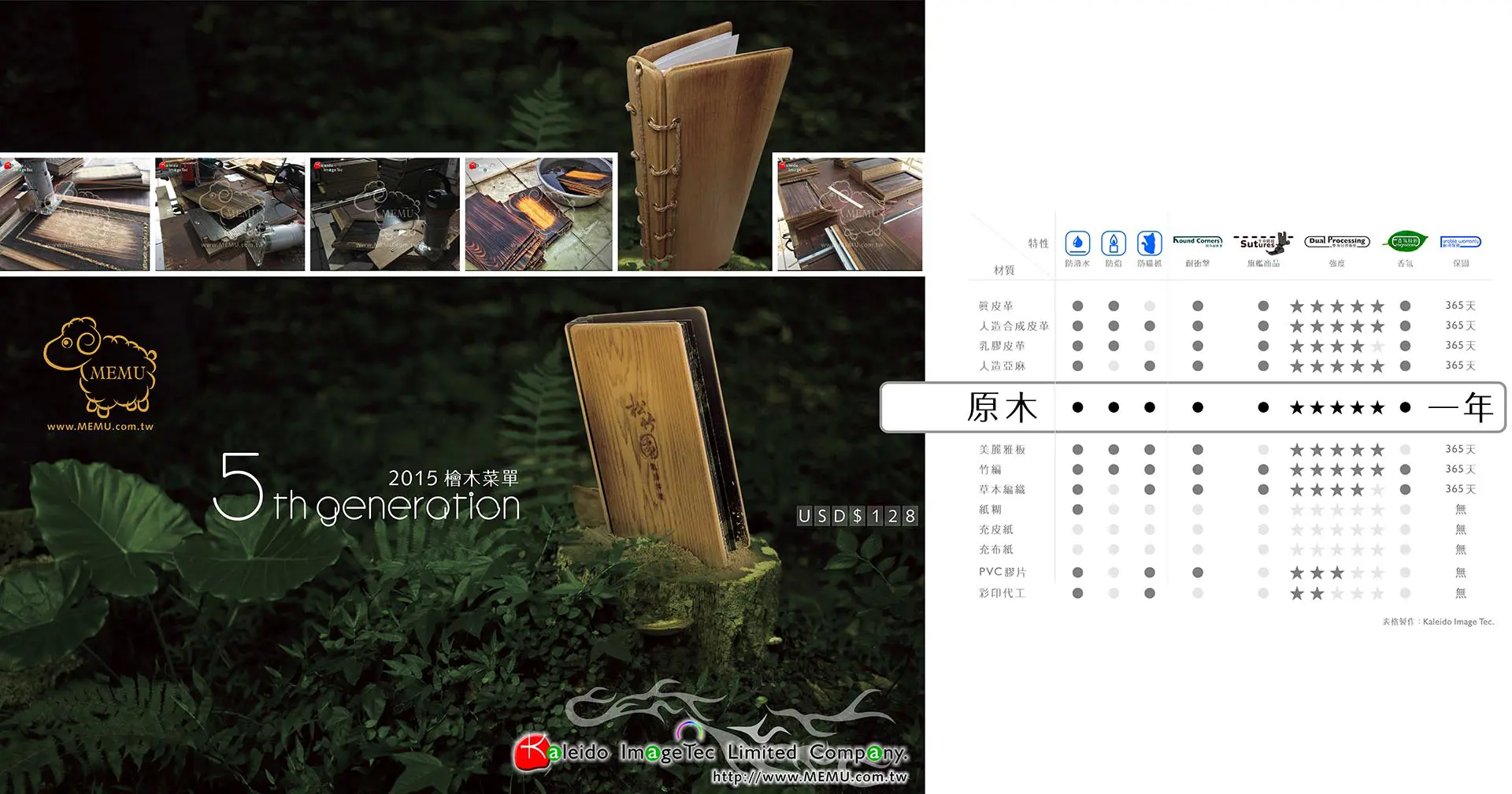
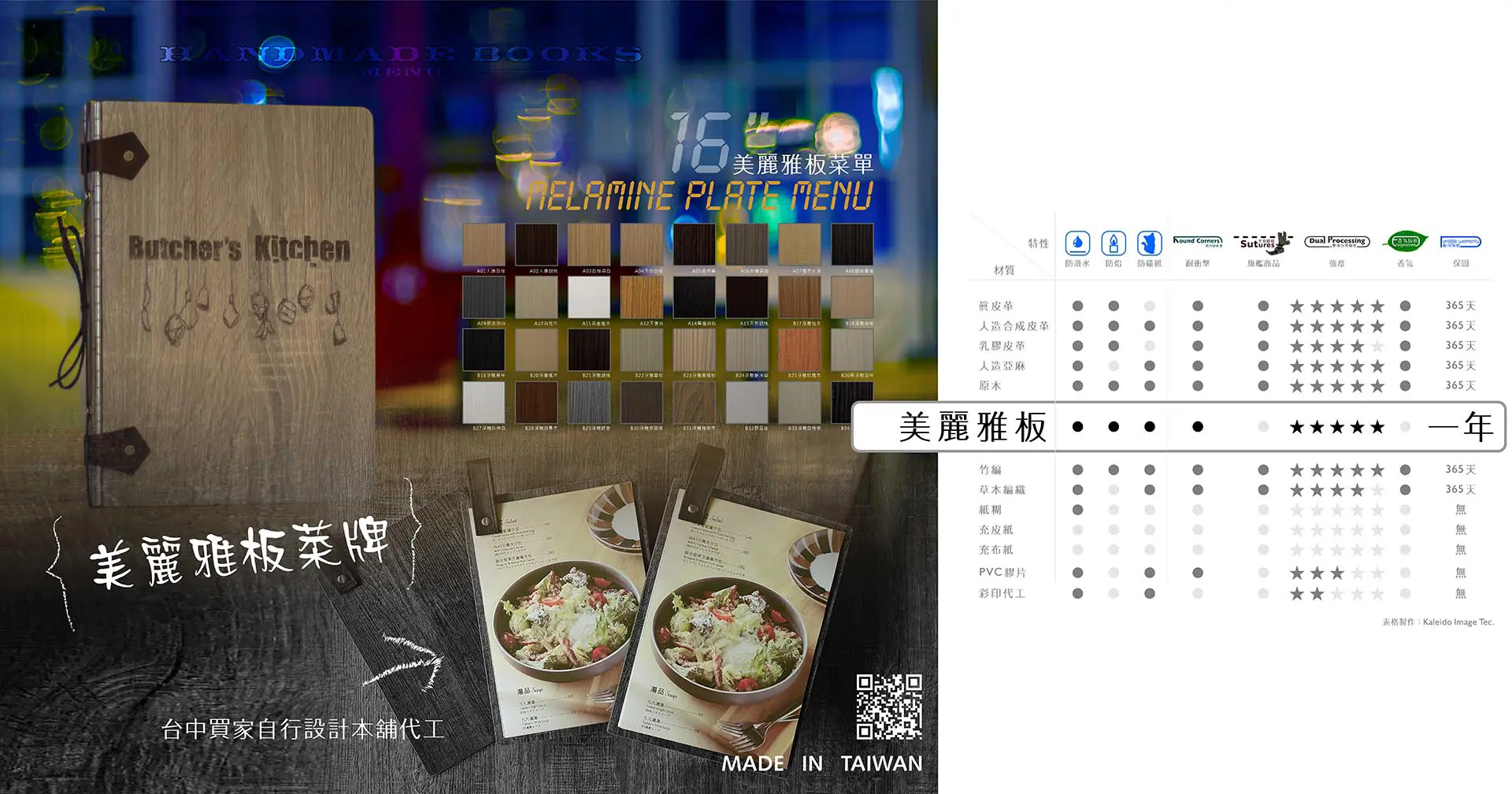
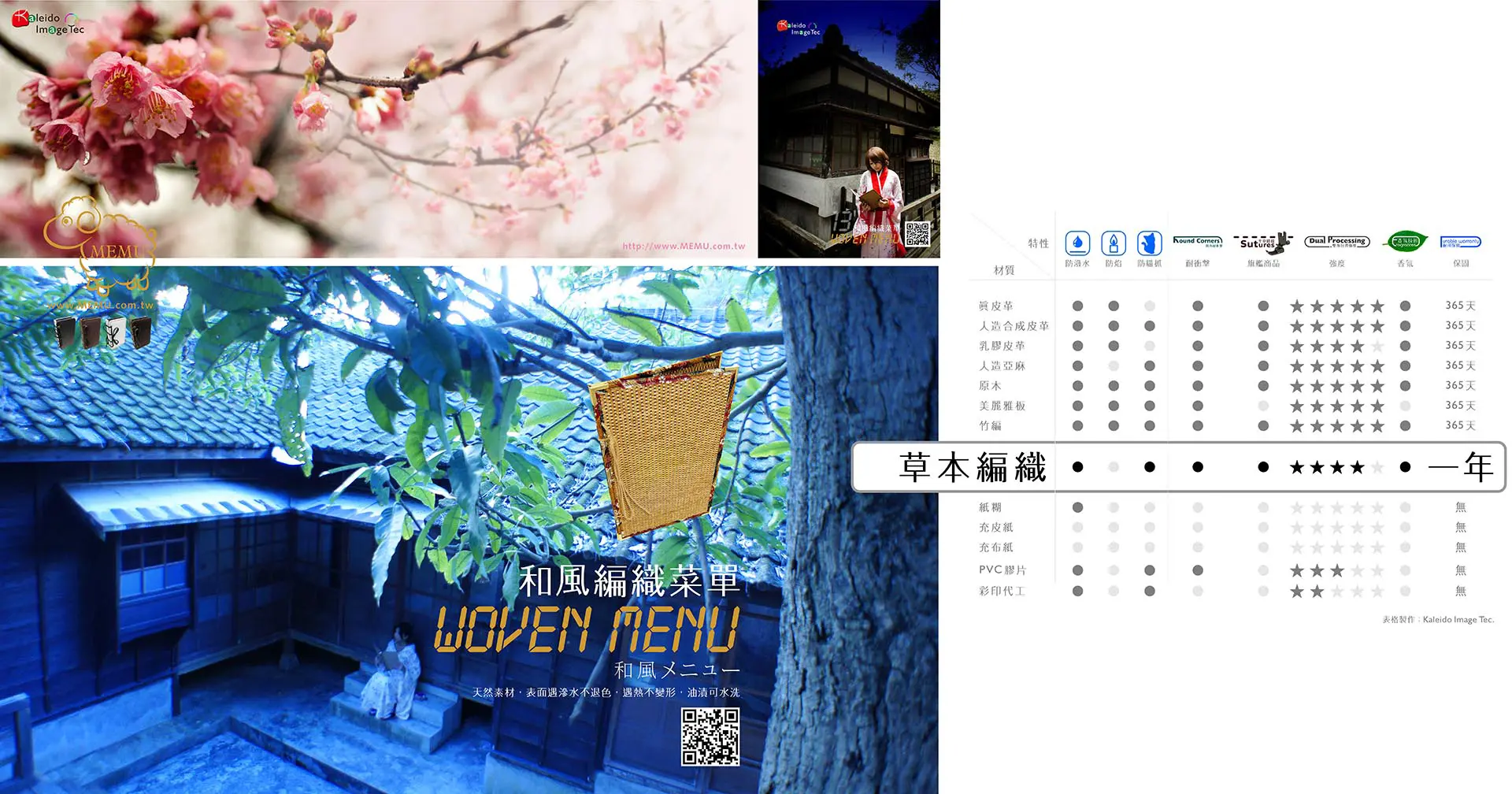
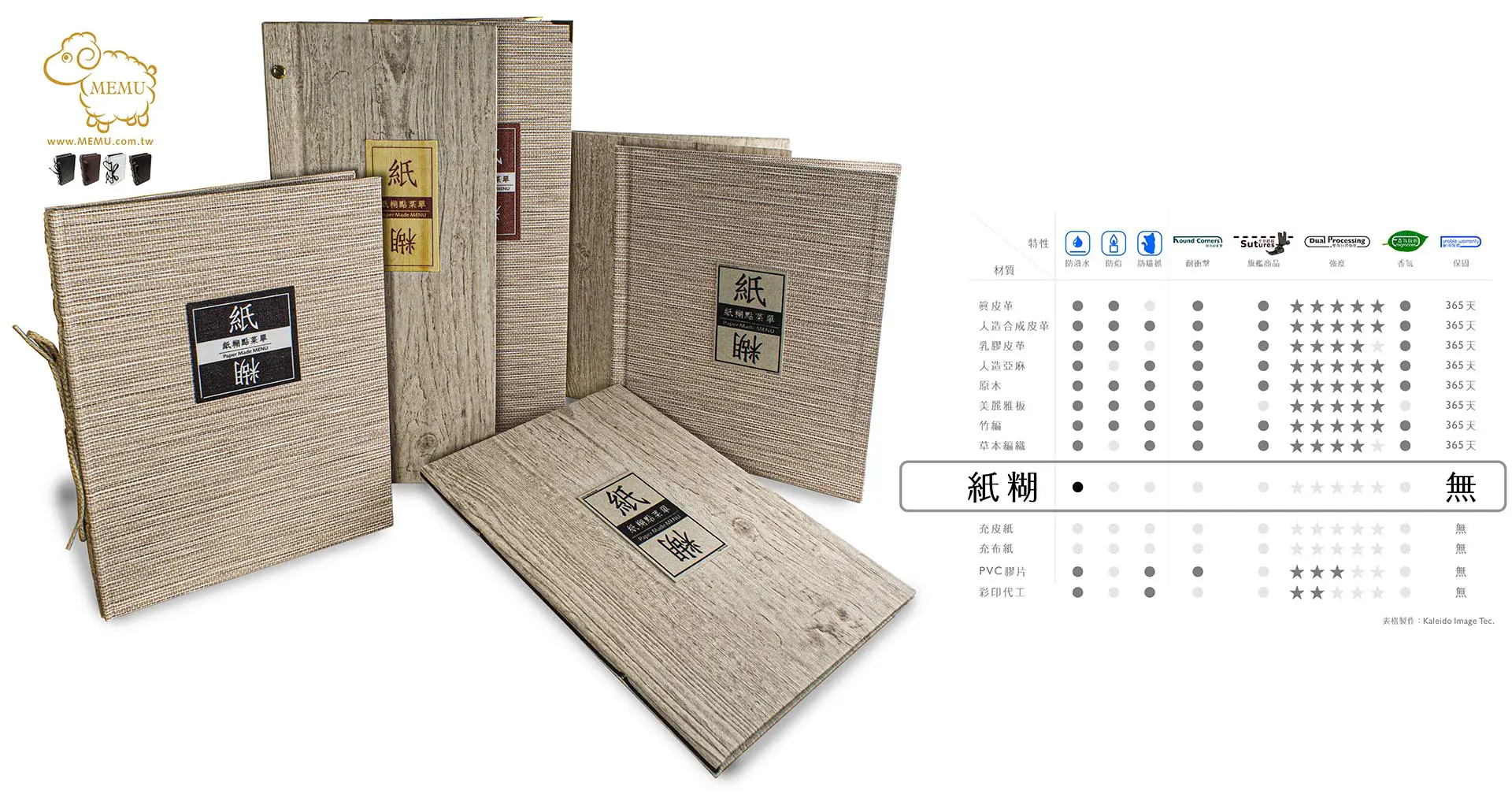
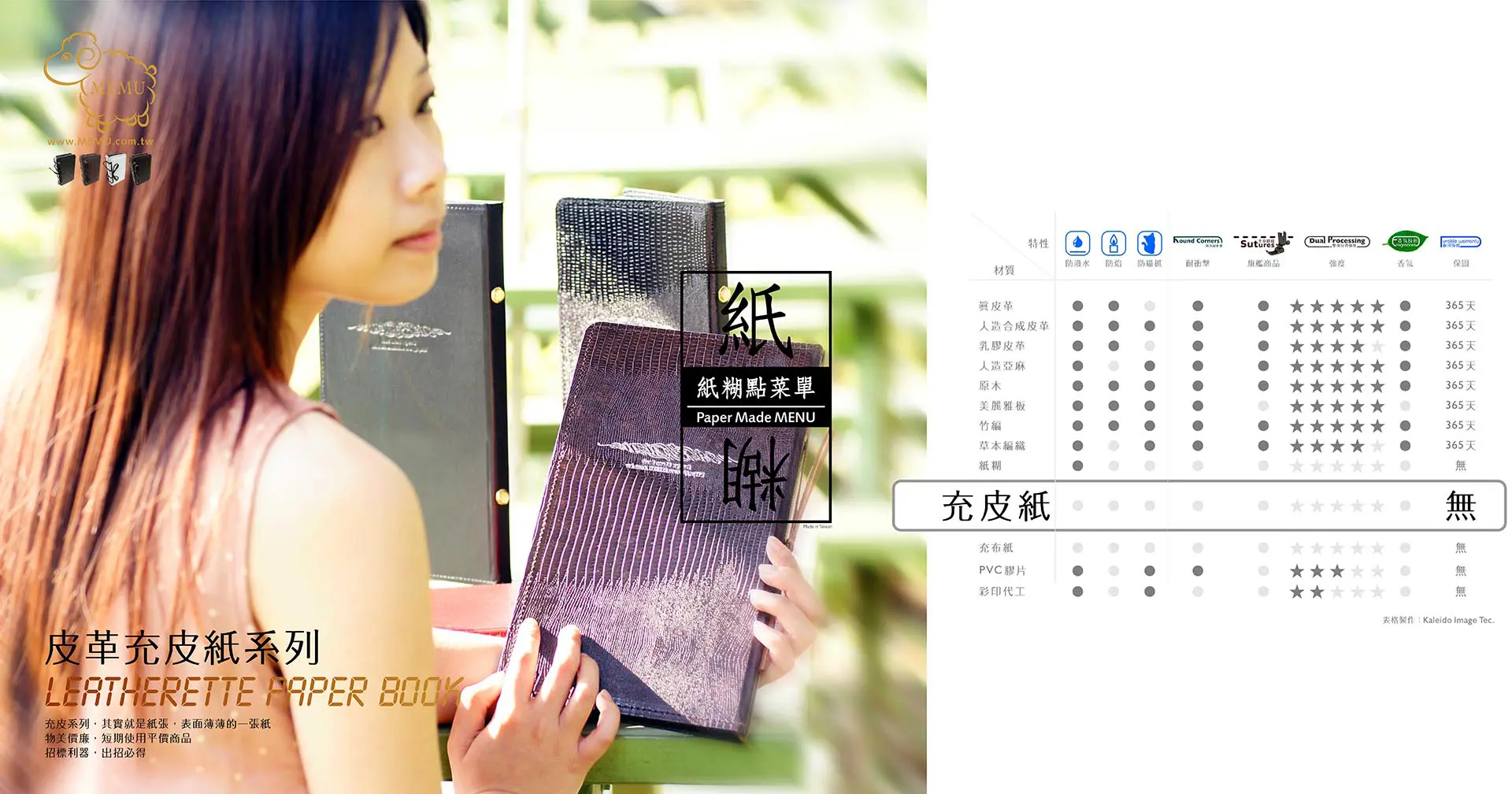
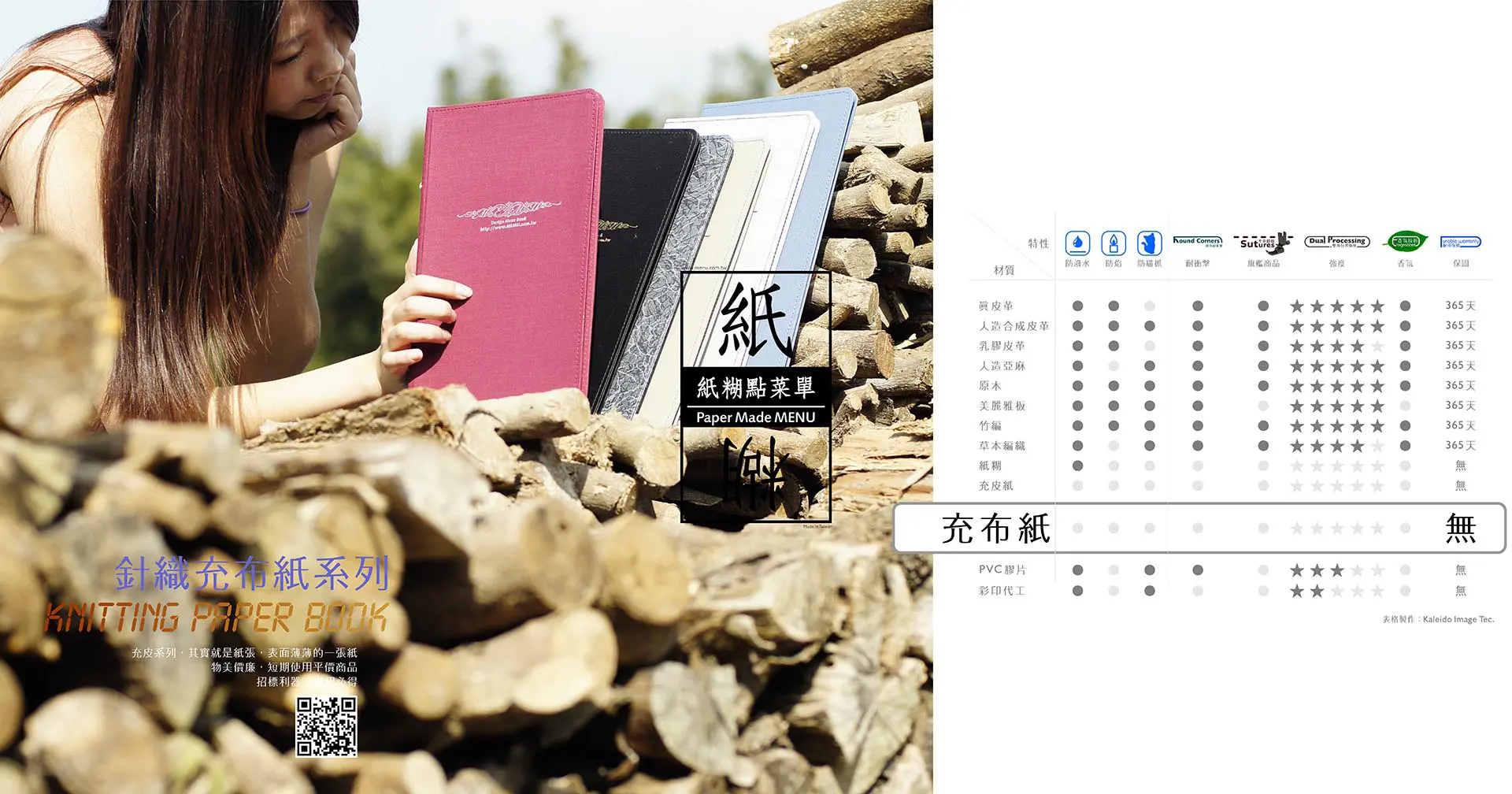
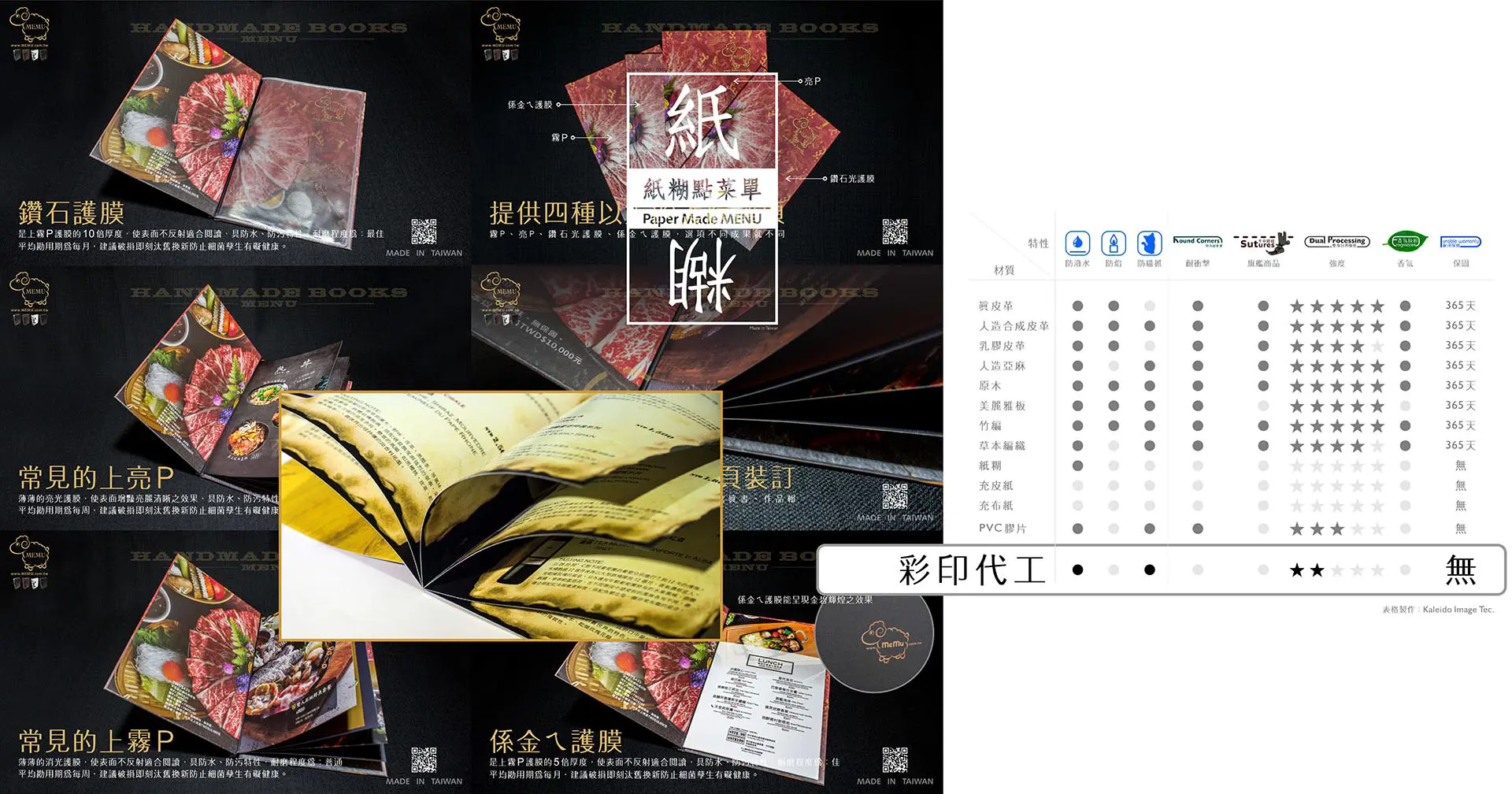
A Brief Introduction to the Origin of the Menu
MENU Types
All menu types are inseparable from MENU. So what is MENU? A well-known online encyclopedia once debated whether the menu or the recipe came first. Their tedious debate has yet to reach a consensus. Since our shop claims to be orthodox, we naturally have the answer. However, the hearts of nitpickers will be shattered. According to the four letters MENU, the answer has long been given. Don’t believe it? Let’s continue to get goosebumps.
- The first letter of MENU is M. Our shop calls it the M-type menu box or M-type binding. It is an extremely exquisite menu type that has no visible binding on the outside and produces a certain book spine thickness. We recommend choosing one of four types of loose-leaf binding to match: cardboard interior pages, art paper interior pages, invincible menu interior pages, or American menu interior pages. Of course, you can also choose loose-leaf inner page sleeves or fixed 180-pound ivory paper inner pages to save on the budget. Relative to the amount, it gives people a sense of getting more value for their money and is preferred by higher-end restaurants. The number of inner pages can be adjusted depending on the maximum spine thickness, which is about 48 pages due to the weight. We recommend 8-24 pages.
- MENU second letter E. Our shop calls it the “Sandwich Menu Book” or “Sandwich Box”. Actually named the E-type menu book or box, with one sheet placed in the middle of the top and bottom, just like a sandwich, hence the name “Sandwich Menu Book”. The binding is mostly on the left side, and can be bound with string or screws, without a book spine. A decorative book spine can also be added to enhance the binding, but the number of pages inside is not affected. You can put as many pages as you want, even up to ten thousand pages. However, after flipping through more than 24 pages, it will gradually become difficult to turn the pages, unless you use our shop’s exclusive cardboard pages or invincible menu pages for better page turning.
MENU’s third letter is N. Our shop calls it a “folding menu.” Its proper name is simply “folding” because it folds in and out. It is commonly known as a “spring fold,” “Guanyin fold,” “double fold,” “wrapped fold,” and “triple fold.” These varied descriptions and terms are actually incorrect and stem from a lack of knowledge. However, since no one has contested them, they are widely accepted. The number of pages increases according to the number of folds, and the more pages there are, the more difficult it is to fold. We recommend no more than 6-8 pages.
Someone once posted on a well-known encyclopedia website claiming that the folding menu originated from ancient China and was made of sheepskin, used as a diplomatic passport. However, their argument was contradictory and the article was soon removed. The folding menu and the hand scroll have different forms and styles. In dramas, the folding menu is often used as a token, but in real life, ancient tokens have been found to be different from the folding menu. On the other hand, the imperial decree was in the form of a folding menu, which was limited to official use, while the folding menu was widespread among the people. This does not prove that the folding menu originated from China.
Our shop has a different view: in the diary of the great navigator, the folding menu was used to present a complete map. Therefore, it can be seen that its origin cannot be determined, but at least it is known that the folding menu is a portable item widely used in maps.- MENU, the fourth letter is U. This type of menu holder is called the U-shaped single box. It is the most common and basic type of menu holder, which is bound on the side of the spine. There are many binding methods available, such as ropes, screws, elastic cords, metal clips, envelopes, file rods, wine lists, metal rings, rubber rings, U-clips, and atomic clips. The maximum number of pages depends on the adjustment of the spine and is usually within 320 pages. It is recommended to use 8 to 24 pages. U-shaped menu holders are the most widely used and commonly seen. They are usually bound in multiples of four, allowing for pages to lay flat without any dead angles. It is also possible to use a bridge connector to switch from four to two multiples, making the U-shaped menu holder the most popular choice.
客來多手創菜單本舖
Kaleido, pronounced “keh-lay-doh”, is legally registered as “Kaleido Handmade Menu Studio”. Kaleido Image Tec.© produces handmade menus that have been passed down from ancient artisans. The inheritors of this craft inherited a well-known gourmet magazine in the 1980s and were awarded numerous News Bureau Magazine Publication Golden Tripod Awards in Taiwan during that time. In the 1990s, these inheritors began to specialize in menu production and have continued to shine in this field.
Initially, Kaleido was just a simple design, but with the changing times, it has evolved into a company with product design, development, and production capabilities. Kaleido has improved on the methods of the past to meet modern demands and consumer habits, endowing menus with more flexible applications. The resulting menus are not only more durable but also aesthetically pleasing and resistant to mold and bacteria. Additionally, Kaleido can work with buyers to customize the product specifications through ODM (Own Designing & Manufacturing) and design or improve products accordingly.
MEMU is Kaleido’s handmade brand, established in 1995. This brand offers a complete range of custom-made products and handmade items have been marketed in countries worldwide. Visitors are welcome to make appointments to view the variety of products, and custom orders and OEM are also welcome as new products and creations are frequently launched. Kaleido Handmade Menu Studio not only has a rich cultural heritage but also continually innovates and pursues excellence in the modern industry. The handmade menus produced by Kaleido are not only aesthetically pleasing but also practical, durable, and washable, making them the preferred choice of major restaurants, hotels, and cafes. With its excellent product quality and service, Kaleido has gradually become a leader in the handmade design industry.
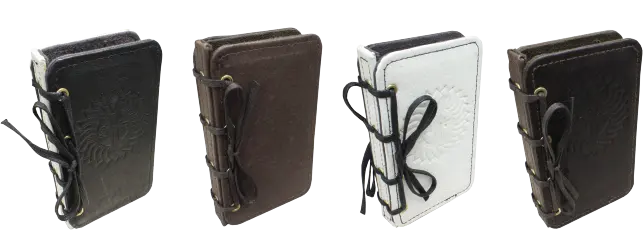
Paper Made MENU
Detailed explanation of paper-mache menu
Based on the four letters M, E, N, and U, the paper menu suggests only producing the E or U types. The M type is expensive to produce, and using paper mache would be meaningless. Additionally, the N type would likely be damaged if made with paper mache, making such an investment seemingly pointless. This conveys a simple concept: when reading magazines and books privately, people are usually careful and flip through the pages slowly. However, when available for the public to read, the damage rate from flipping through the pages is actually quite high. This gives us a hint: paper should be used for the interior pages, and the interior pages need a beautiful cover with a practical, durable, and ring-bound box.
Formosa Taiwan

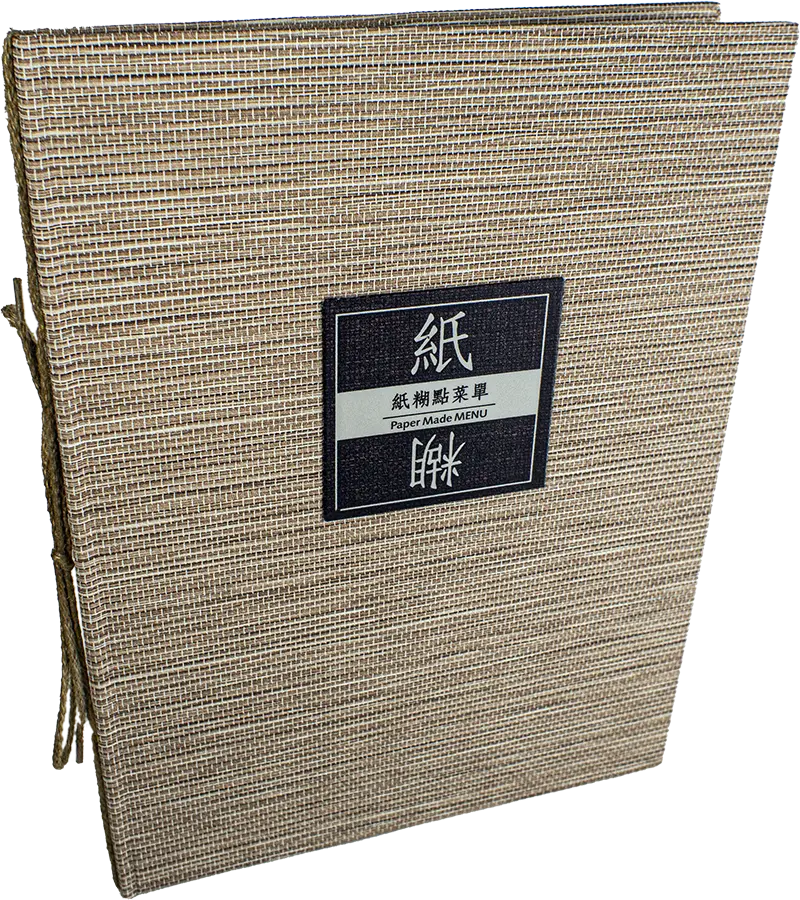
Standard U-shaped box
Doesn’t the texture look great in the picture? It’s love at first sight, and holding it in your hand gives you a transcendent and noble literary atmosphere. There’s no consideration for durability, ruggedness, or even cleanliness. The price is affordable and it’s worth every penny. For vertical A4 specifications and below, the unit price for each book is only USD $14.5 up, with guaranteed extra waterproofing. You don’t have to worry about organic substances such as oil stains, beverages, soup, soy sauce, vinegar, etc.
Minimum order quantity is 30 books for A4 specifications.
- For single transactions of vertical A4 specifications and below, the minimum order quantity is 10 books, for example, 30, 40, 50, and so on.
- For single transactions of vertical A3 specifications, the minimum order quantity is 5 books, for example, 15, 20, 25, and so on.
The consumption rate of paper menu printing is fast, so it is recommended to purchase 100 books at once to take advantage of the discount.
Three binding options are available: screws, flat ropes, and file rods.
Inner pages must be purchased separately and support all inner page specifications. The paper menu does not come with inner pages, but the buyer can handle this on their own.
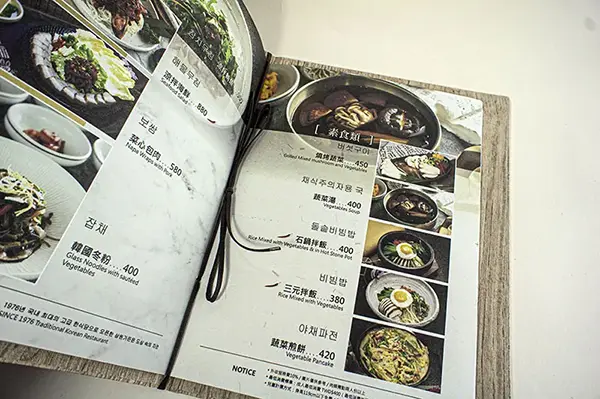
flat rope binding
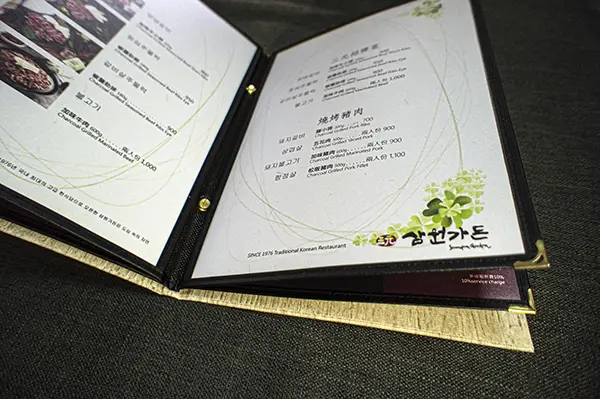
screw binding
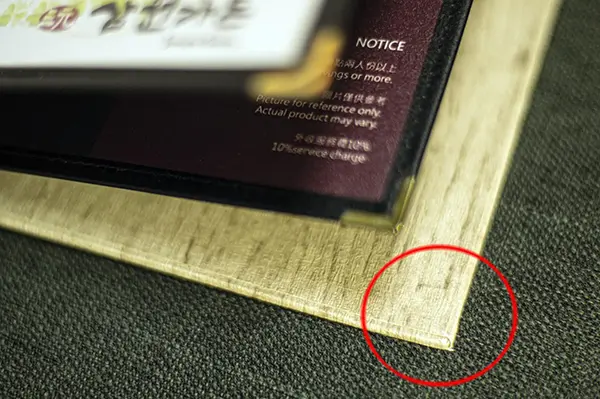
Hardcover only
E-shaped box
E-type cartons, also known as sandwich cartons, are used in this menu. The menu size is A3, with inner pages measuring 17x42cm, and each unit costs approximately USD$36.4 and up. The minimum order quantity for a single transaction is at least 5 units, and for vertical A4 specifications and below, the unit price is only USD$18.2 and up. They are guaranteed to be water-resistant and strengthened against spills of organic substances such as oil stains, drinks, soup, soy sauce, vinegar, etc.
For A4 specifications, the minimum order quantity per transaction is 30 units or more.
- For vertical A4 specifications and below, the minimum order quantity per transaction is at least 10 units, such as 30, 40, 50, etc.
- For vertical A3 specifications, the minimum order quantity per transaction is at least 5 units, such as 15, 20, 25, etc.
The consumption rate of paper menus is very high, so it is recommended to purchase 100 units at a time to take advantage of discounts.
Three binding options are available: screws, flat ropes, and file rods.
Inner pages must be purchased separately and support all inner page specifications. The paper menu does not come with inner pages, but the buyer can handle this on their own.
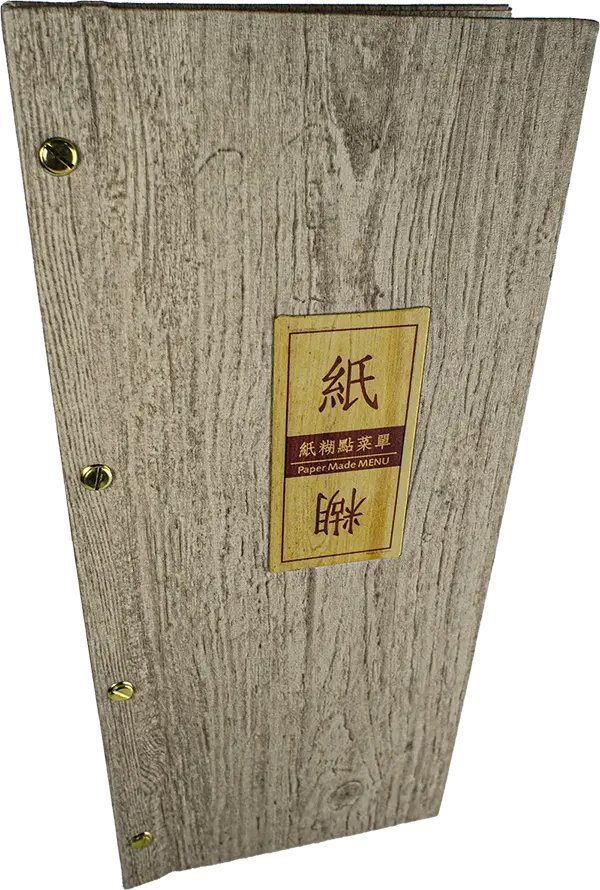
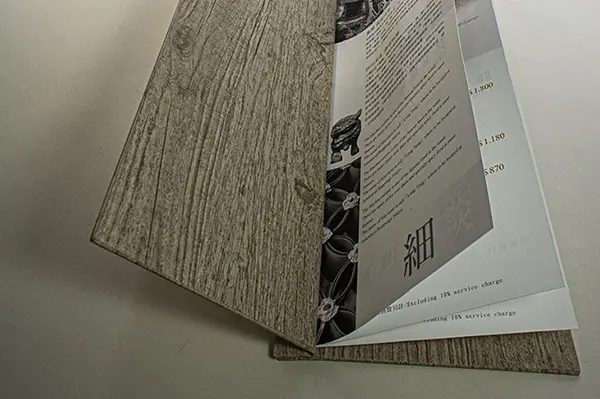
Double inner page
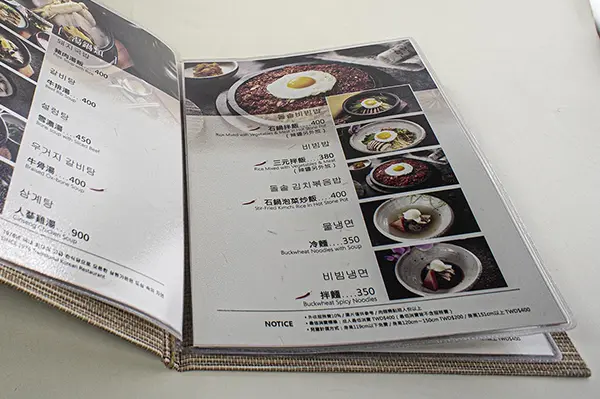
Inner Page Plastic Sleeve A.B.C.
The double-page inner sleeve comes in two types:
- A- style with a side-opening
- B- B-style with a closed design, and
- C- C-style with a top-opening, all of which must be purchased separately. The sandwich box has no upper or lower limit on the number of pages.

Hardcover only
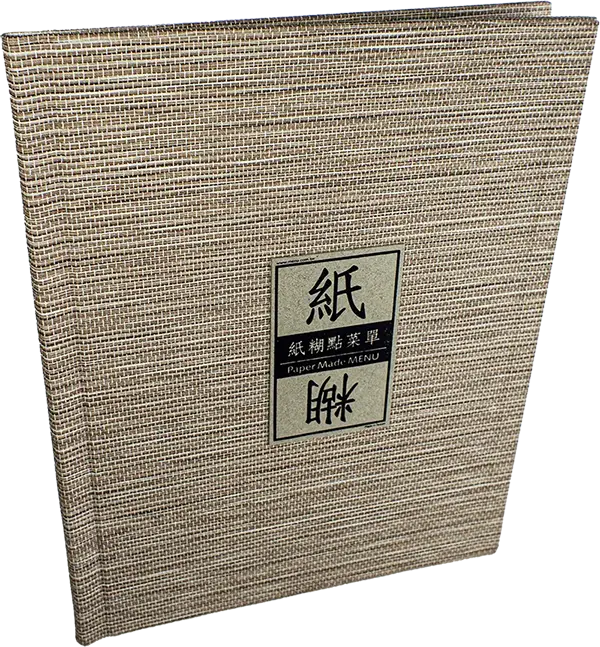
Document pole binding
The menu books with document binding can only be produced in vertical A4 format or smaller, with a unit price of USD$14.5 up, guaranteed to be water-resistant and reinforced to resist organic substances such as oil stains, drinks, soups, soy sauce, vinegar, etc. There is also a horizontal A3 format available with a unit price of USD$29 up.
The minimum order quantity for A4 size menu books is 30 books per order.
- For direct A4 format, each transaction must have a minimum quantity of 10 books, with a minimum order of 30, 40, 50 books, and so on.
- For horizontal A3 format, each transaction must have a minimum quantity of 5 books, with a minimum order of 15, 20, 25 books, and so on. Due to the high consumption rate of paper menu, it is recommended to purchase 100 books at once for replacement to enjoy additional discounts.
Three binding options are available: screws, flat ropes, and file rods.
Inner pages must be purchased separately and support all inner page specifications. The paper menu does not come with inner pages, but the buyer can handle this on their own.
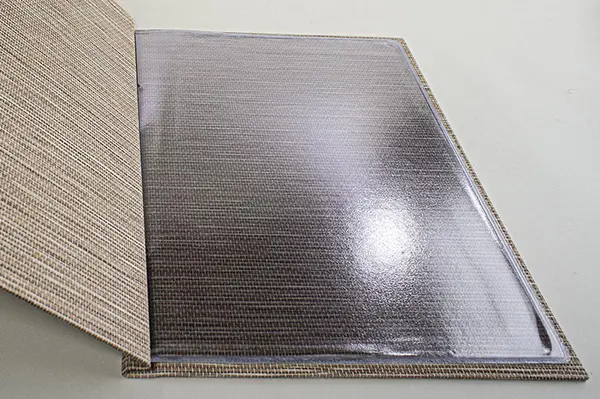
Document rod with inner cover
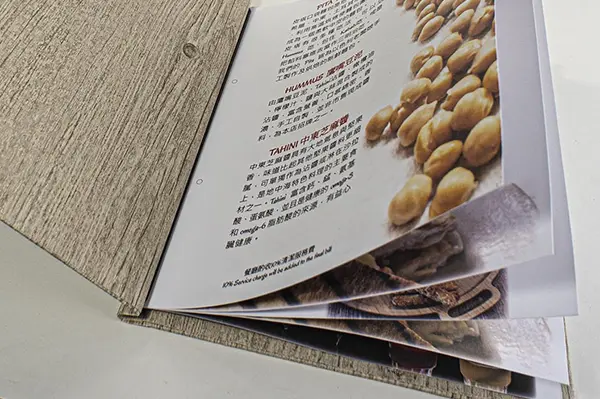
File rod with color printed inner pages.
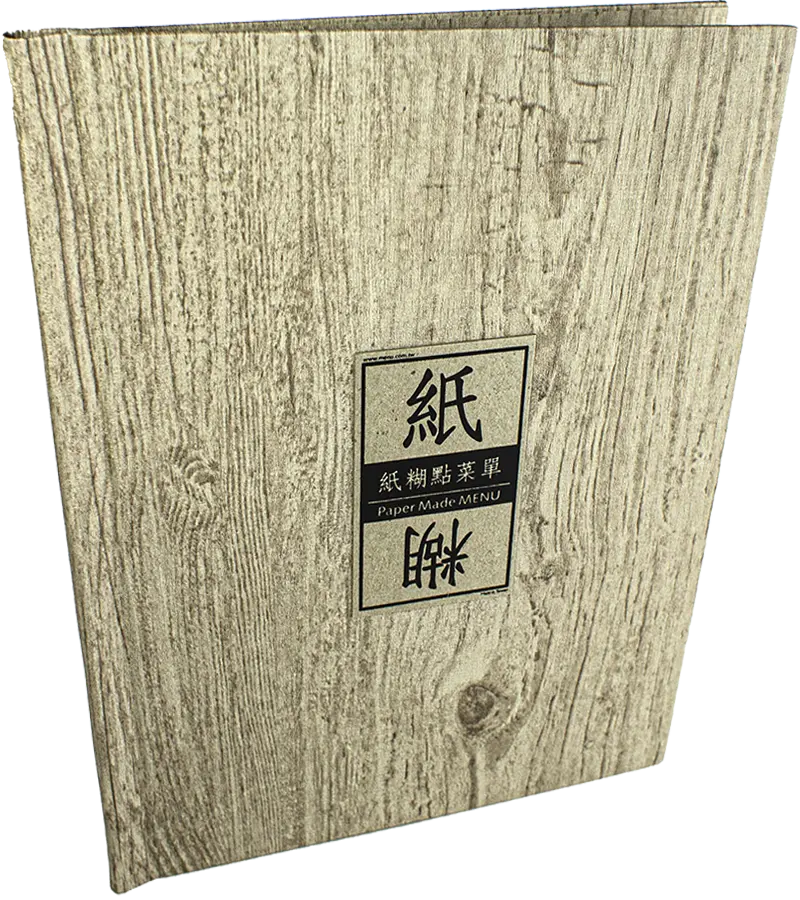
Screw Binding
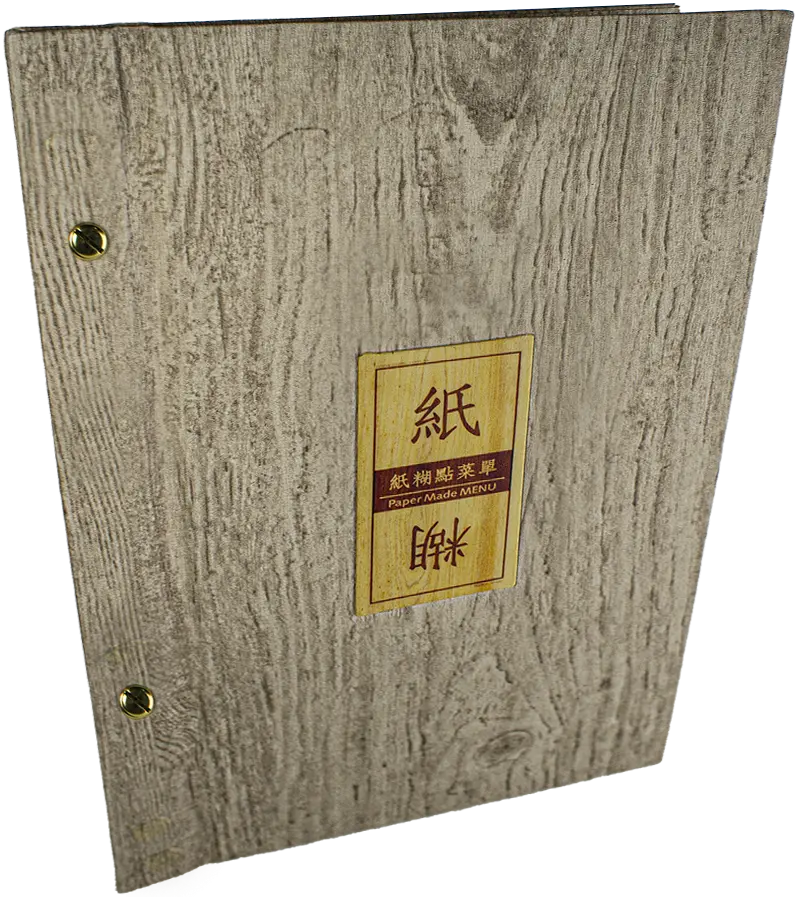
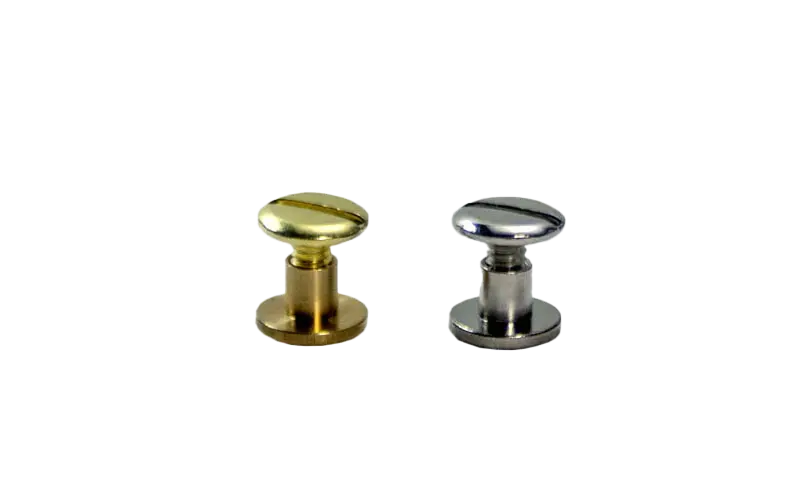
Screw

Screw Position
Flat Rope Binding
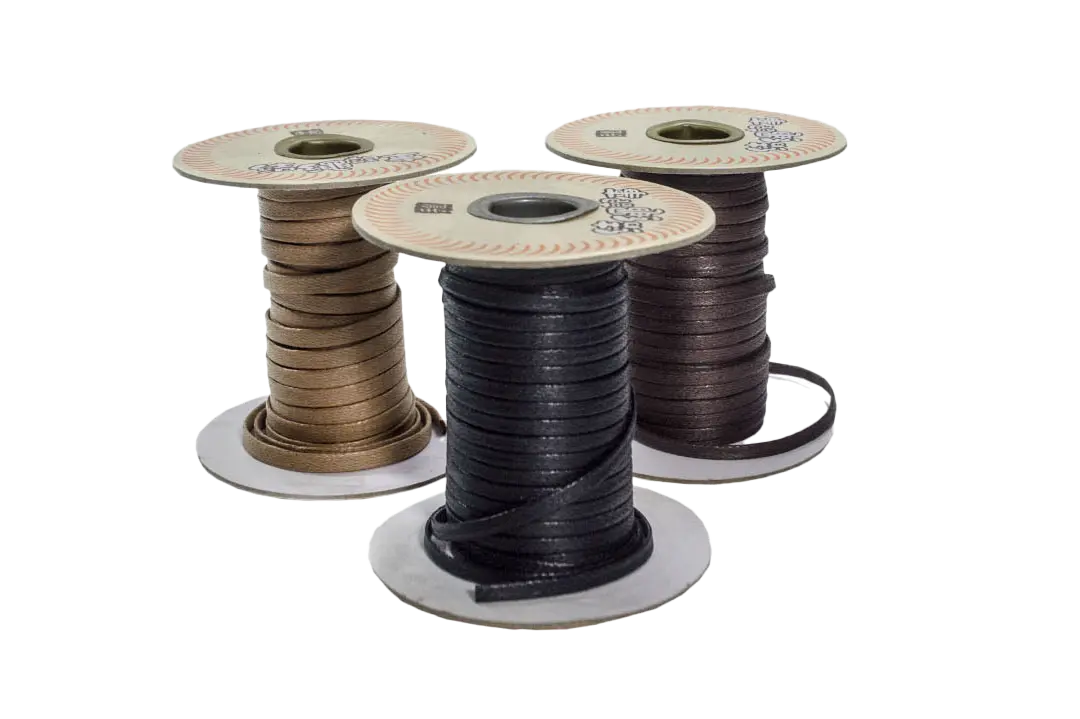
Color Matching

Knot Position

Processing Options
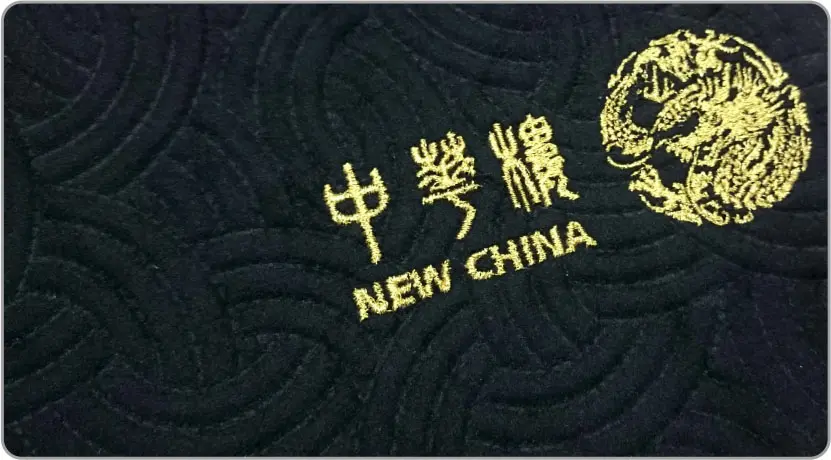
Computer Embroidery
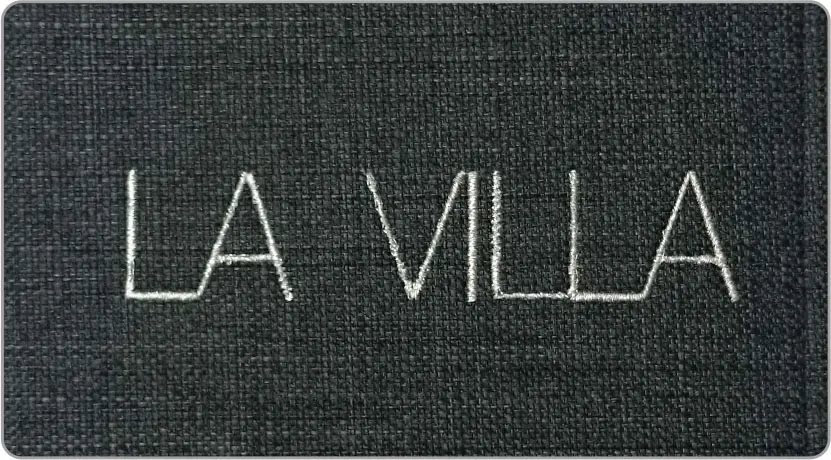
Embroidery thread imported from Japan
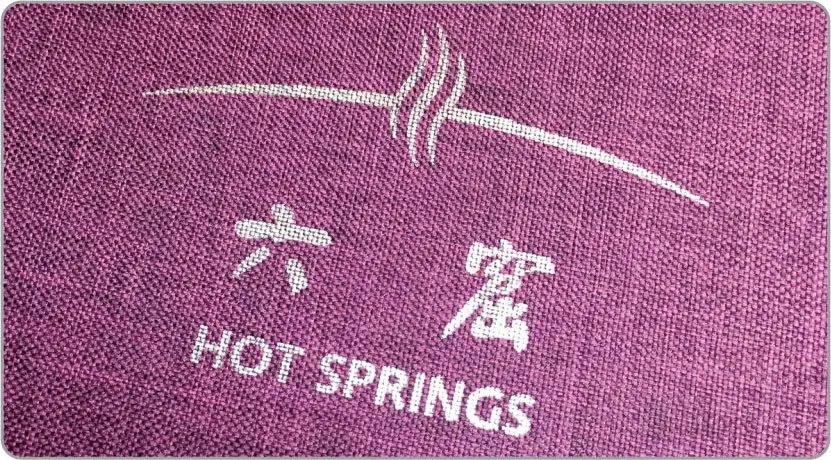
Hot stamping on functional cloth
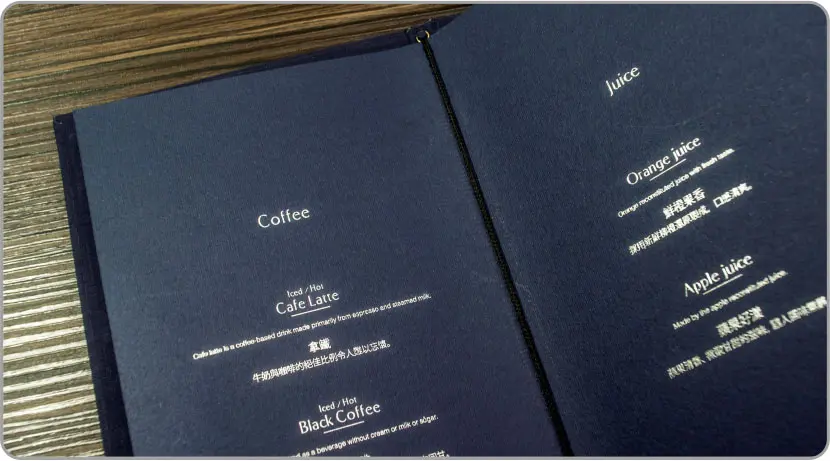
Hot stamped on fine art paper
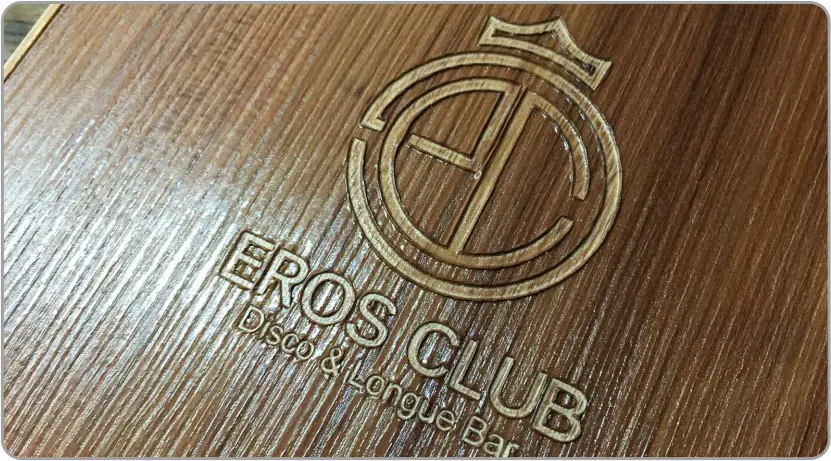
Brand
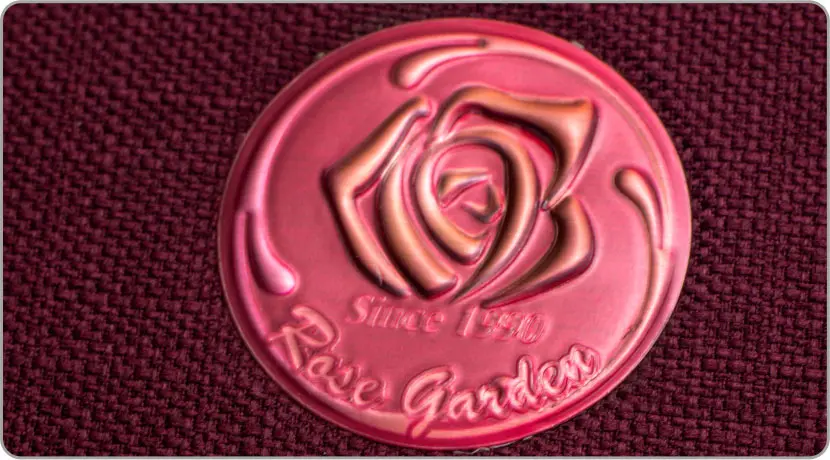
Dye sublimation + Embossing
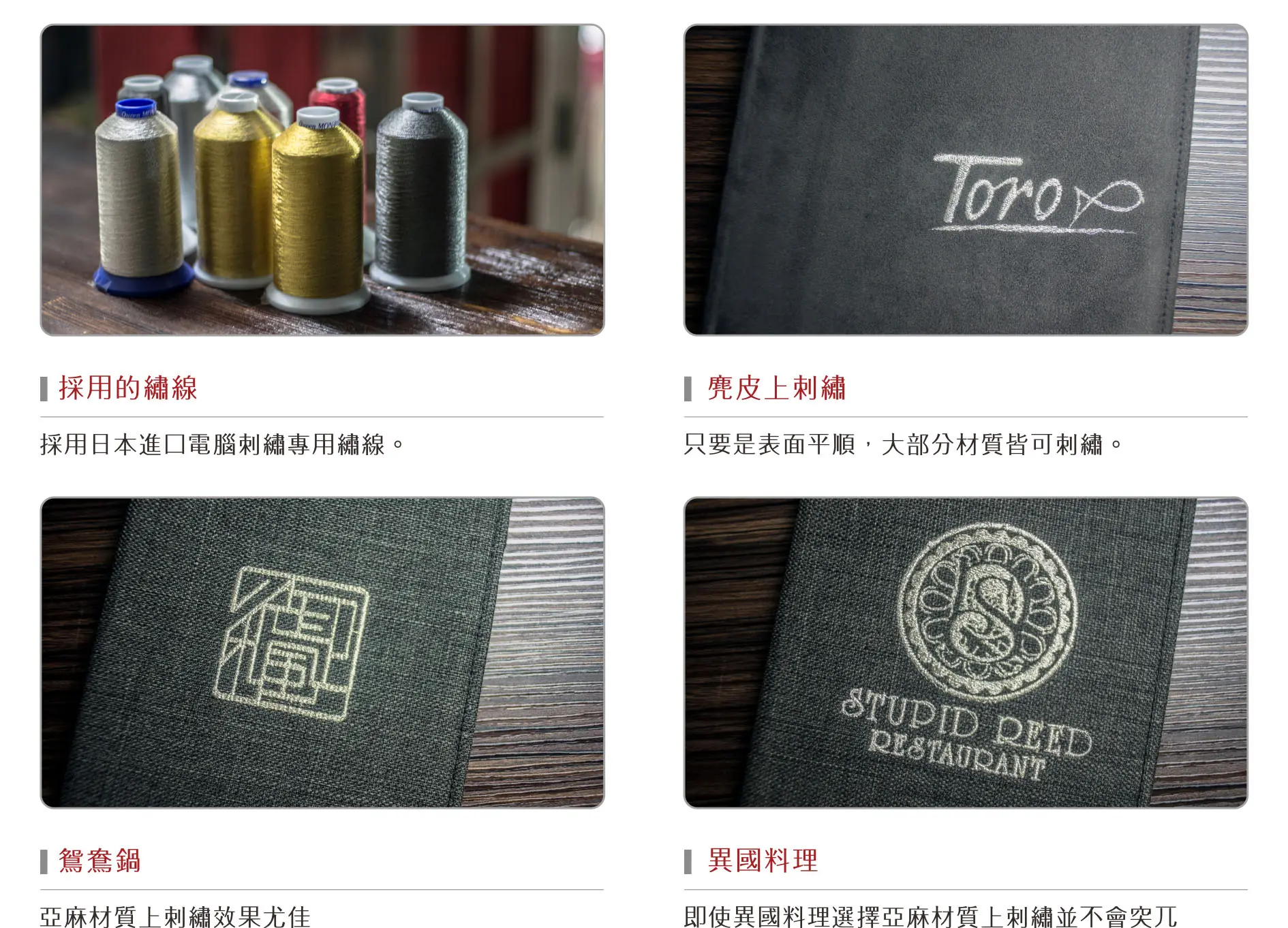
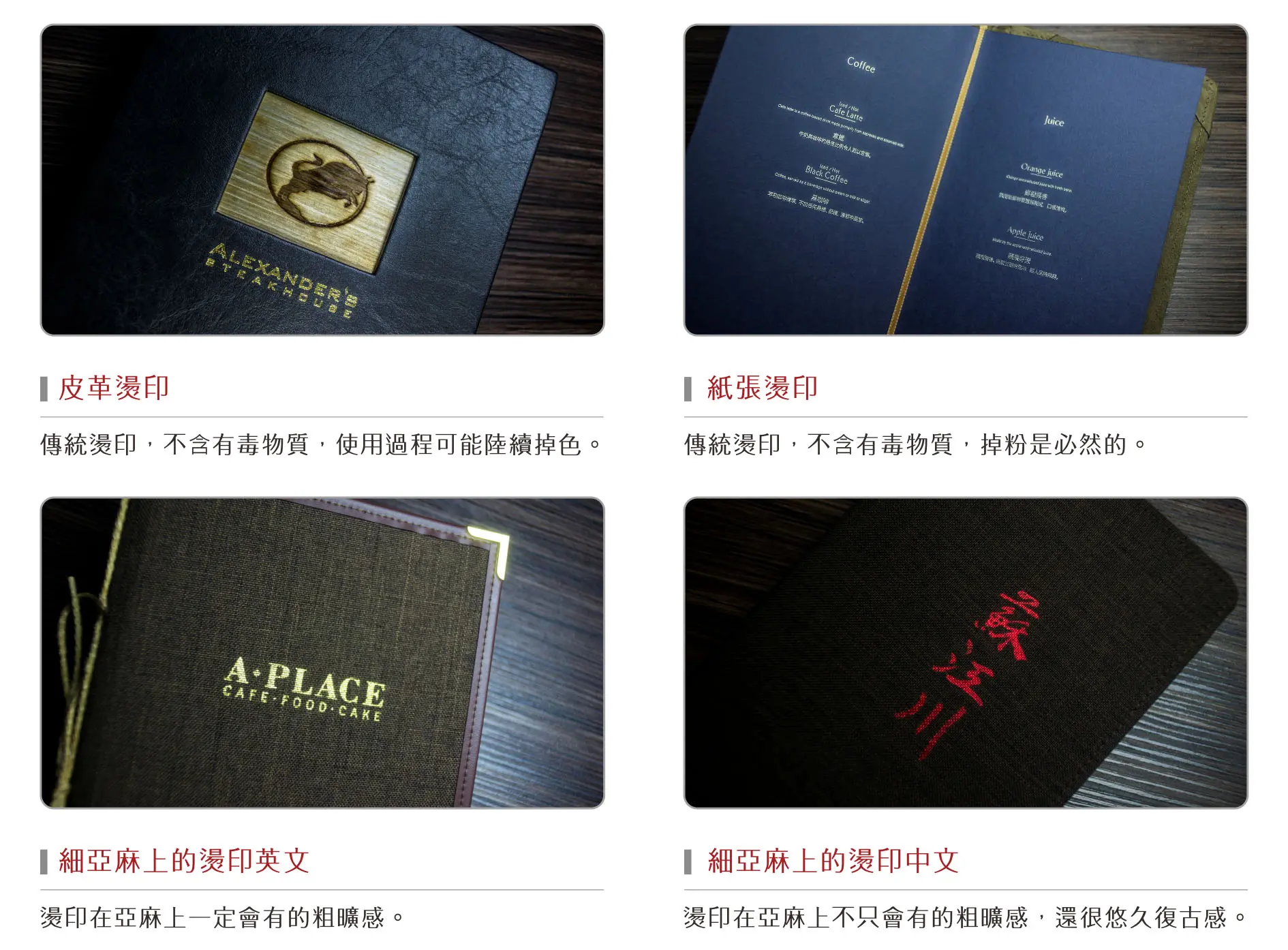
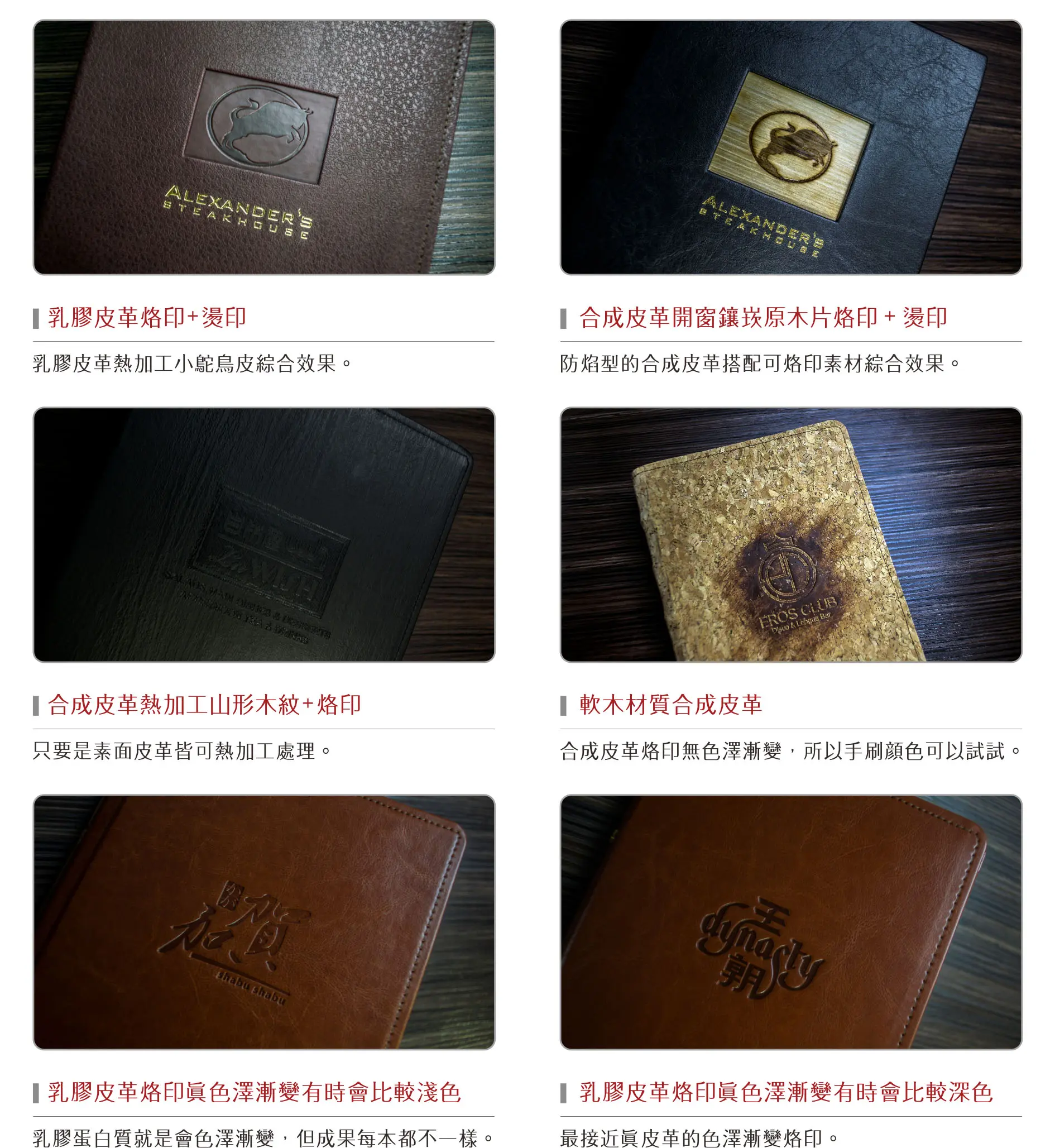
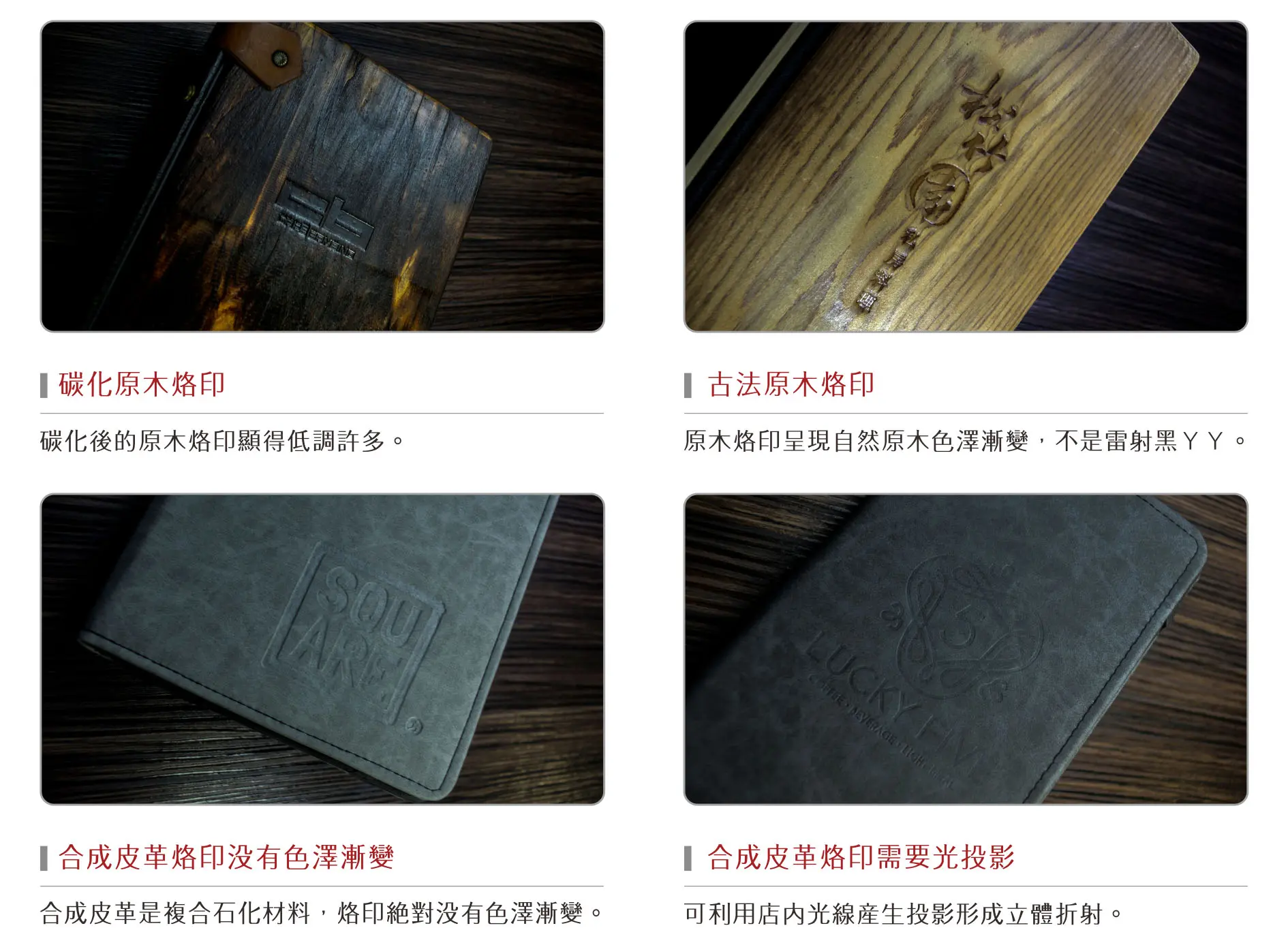
Paper paste point menu-limited recommended processing
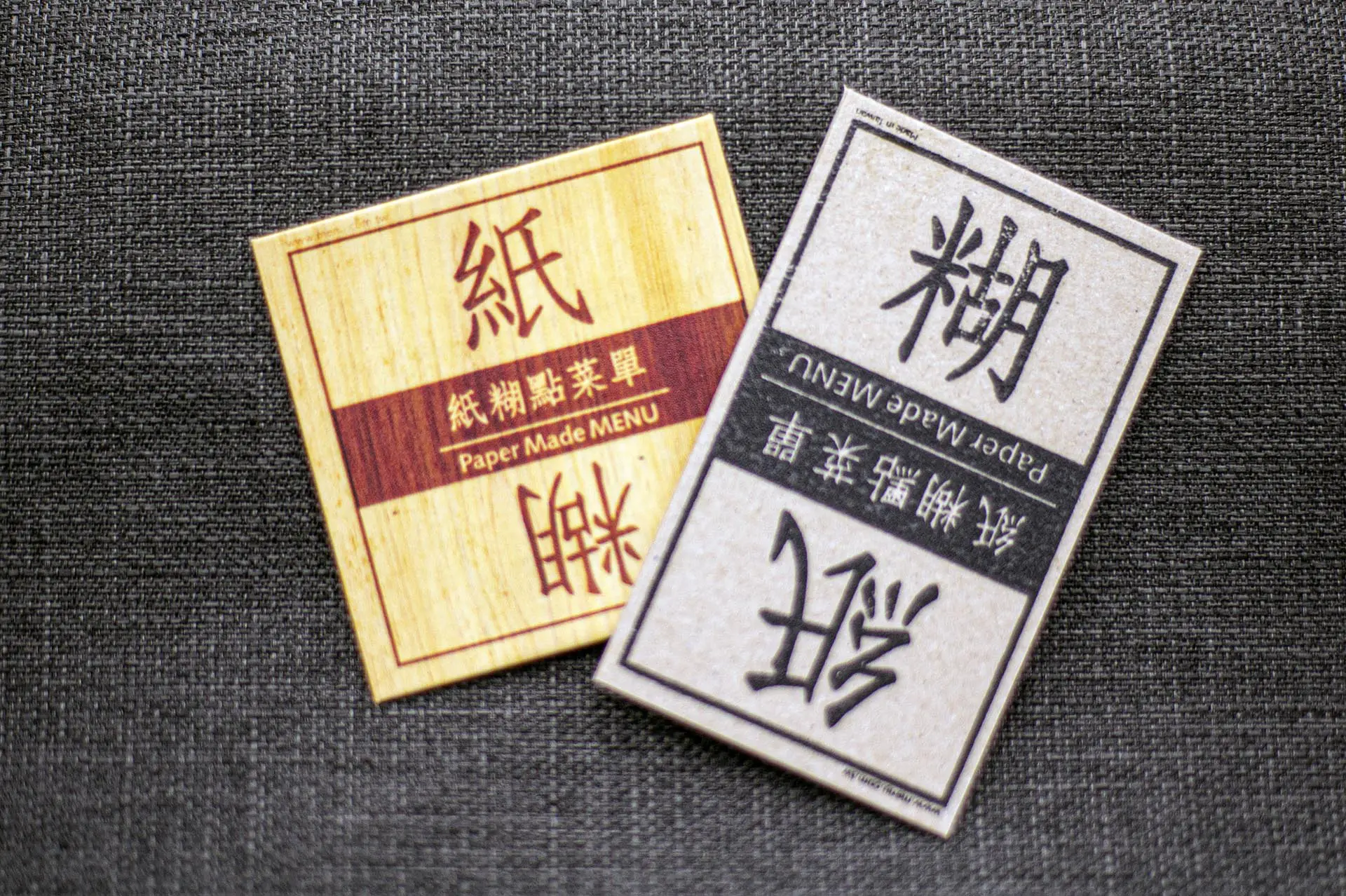
Recommended add-on: Full-color printed store label available for an additional +TWD$150—highly recommended!
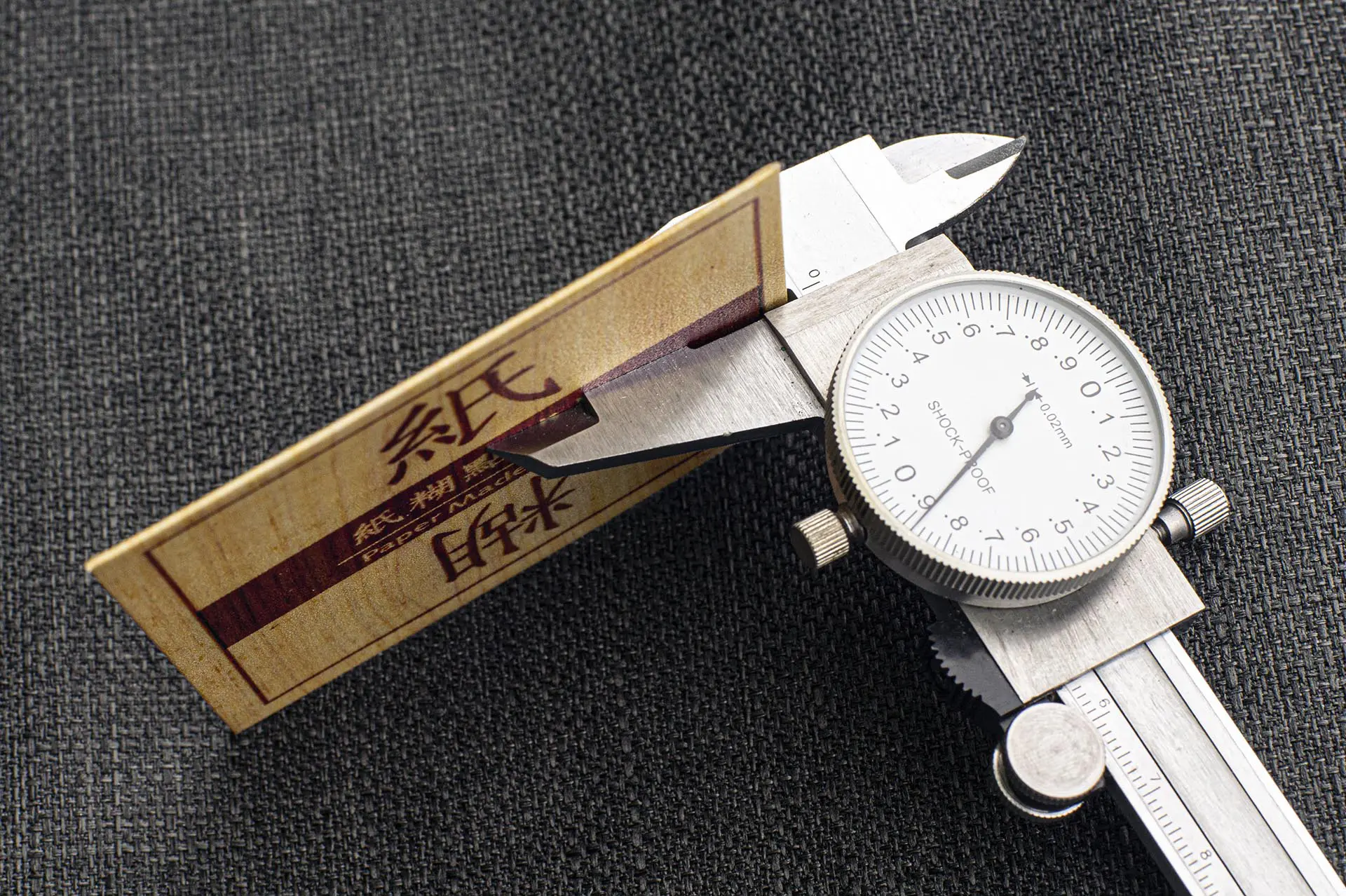
The full-color printed store label is approximately 1mm thick. A recess is first carved out, then the label is inlaid into position.
Lnside Page Options
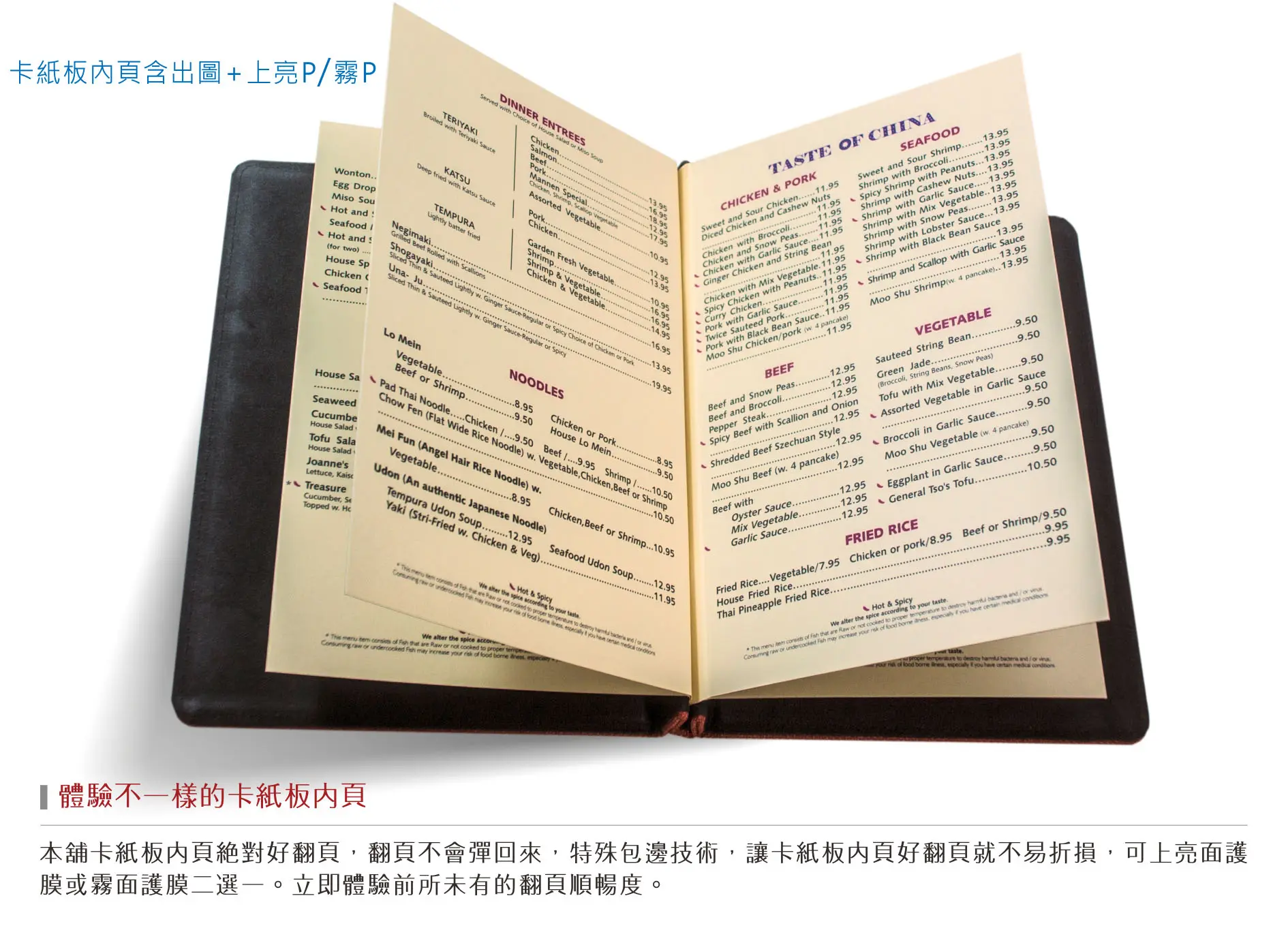
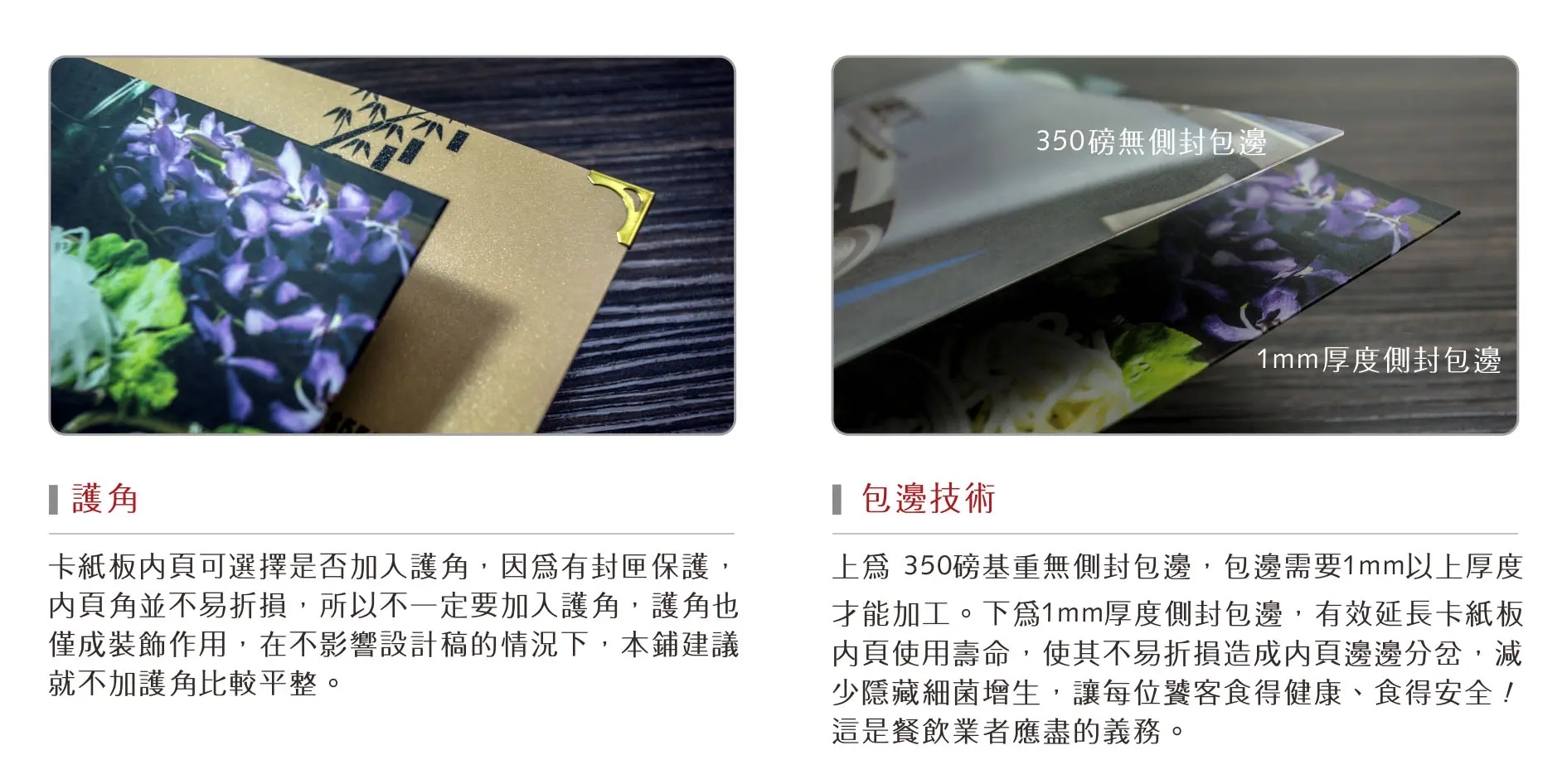
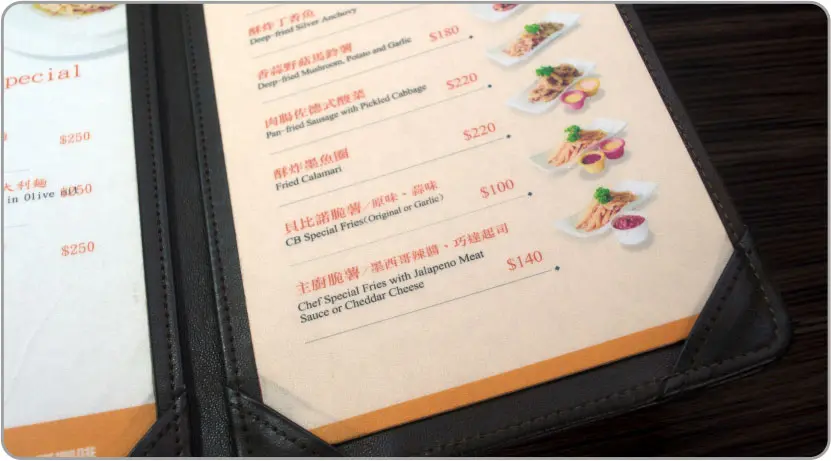
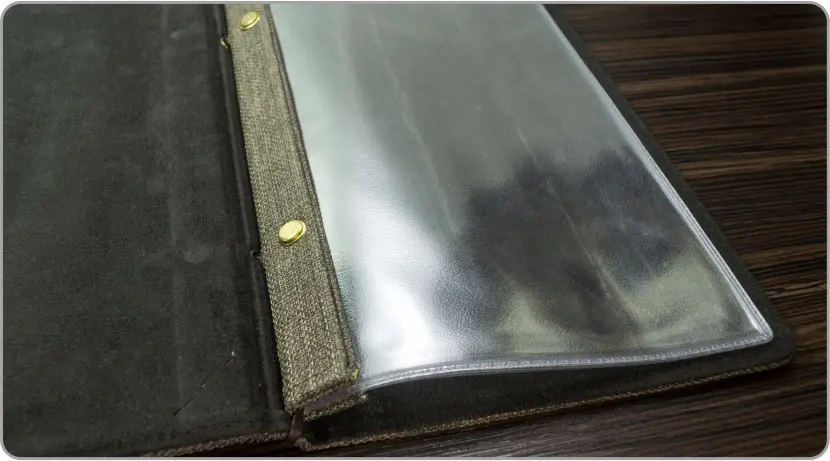
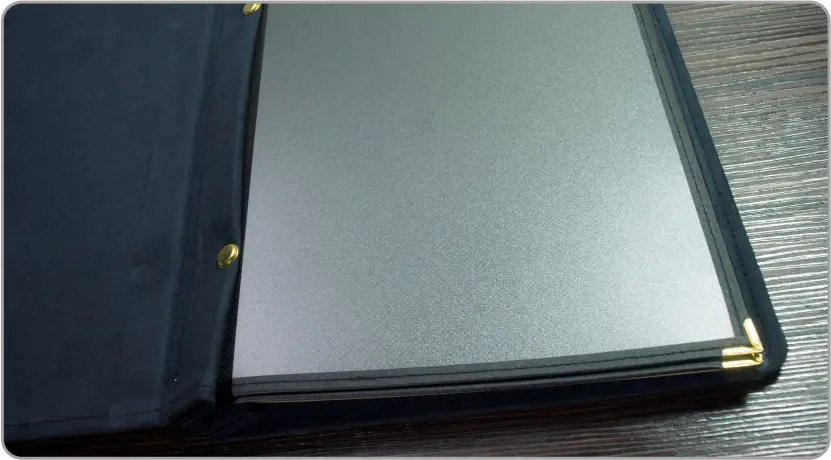
Copyright© 1995-2025 Kaleido Image Tec. 版權所有
客房菜單
Our custom menus are one-of-a-kind and can be tailored to the buyer’s preferences. For room service menus, we intentionally make them thick and sturdy to prevent them from being taken away, but we can also make them small and thin based on the buyer’s needs. The materials used for the inside and outside of the menu can be mixed and matched to provide a wide range of options. We recommend using a four-hole metal clip for quick and easy replacement of the pages during events.
We support a variety of fine art papers for the inner pages.
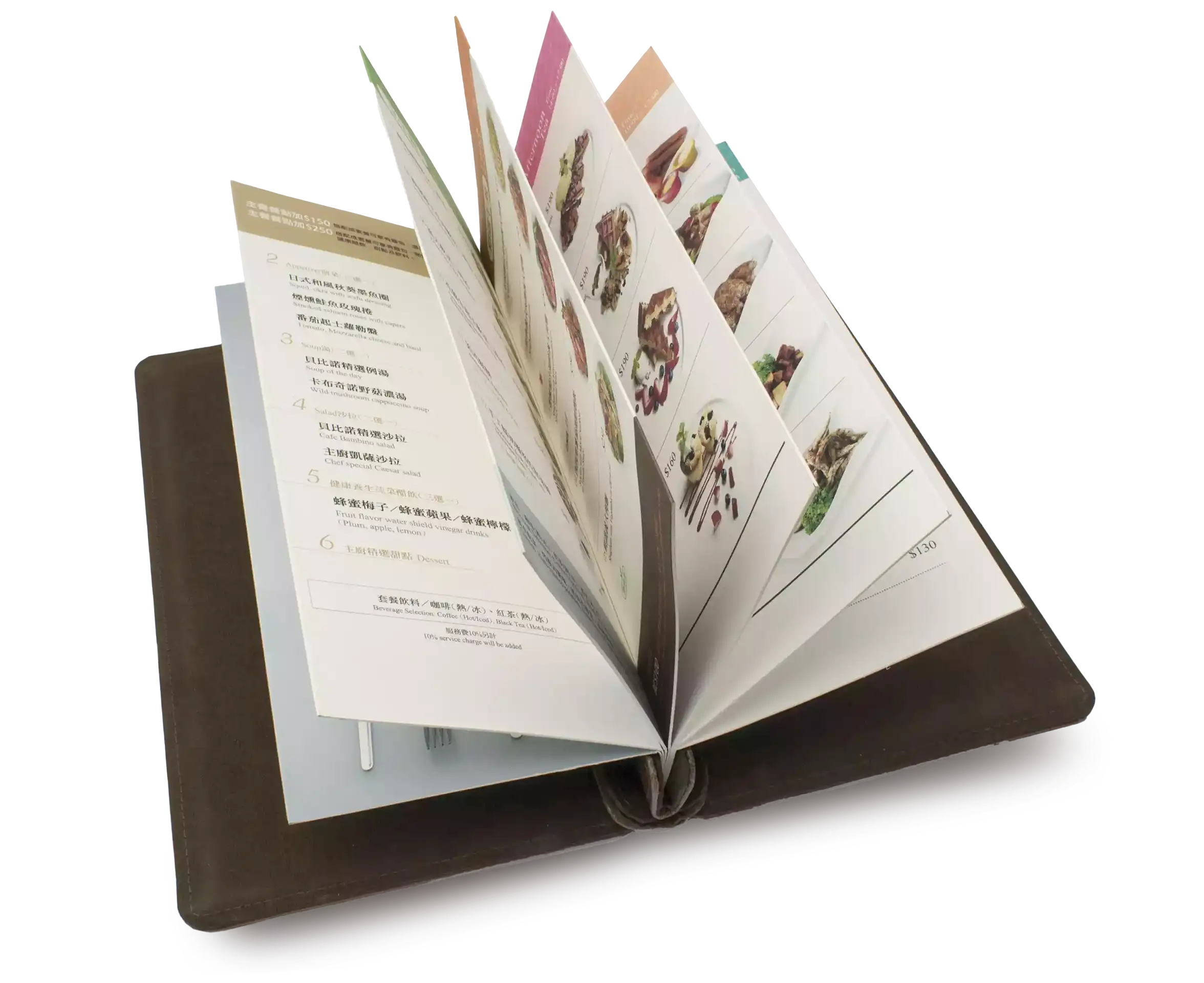
The inner pages of this design utilize our proprietary technology, which includes cardboard pages, and is one of our recommended options. The entire series features pages that can be easily added, removed, or replaced, and we support the purchase of various types of fine art paper, waterproof paper, cardboard pages, and magazine paper for the inner pages. If you prefer not to use PVC materials, the aforementioned materials can be purchased separately for use as inner pages. However, only our shop’s products feature inner pages that are easy to flip, durable, without rebounding, and without cracking or splitting along the spine. For estimated production time and costs, please feel free to inquire.
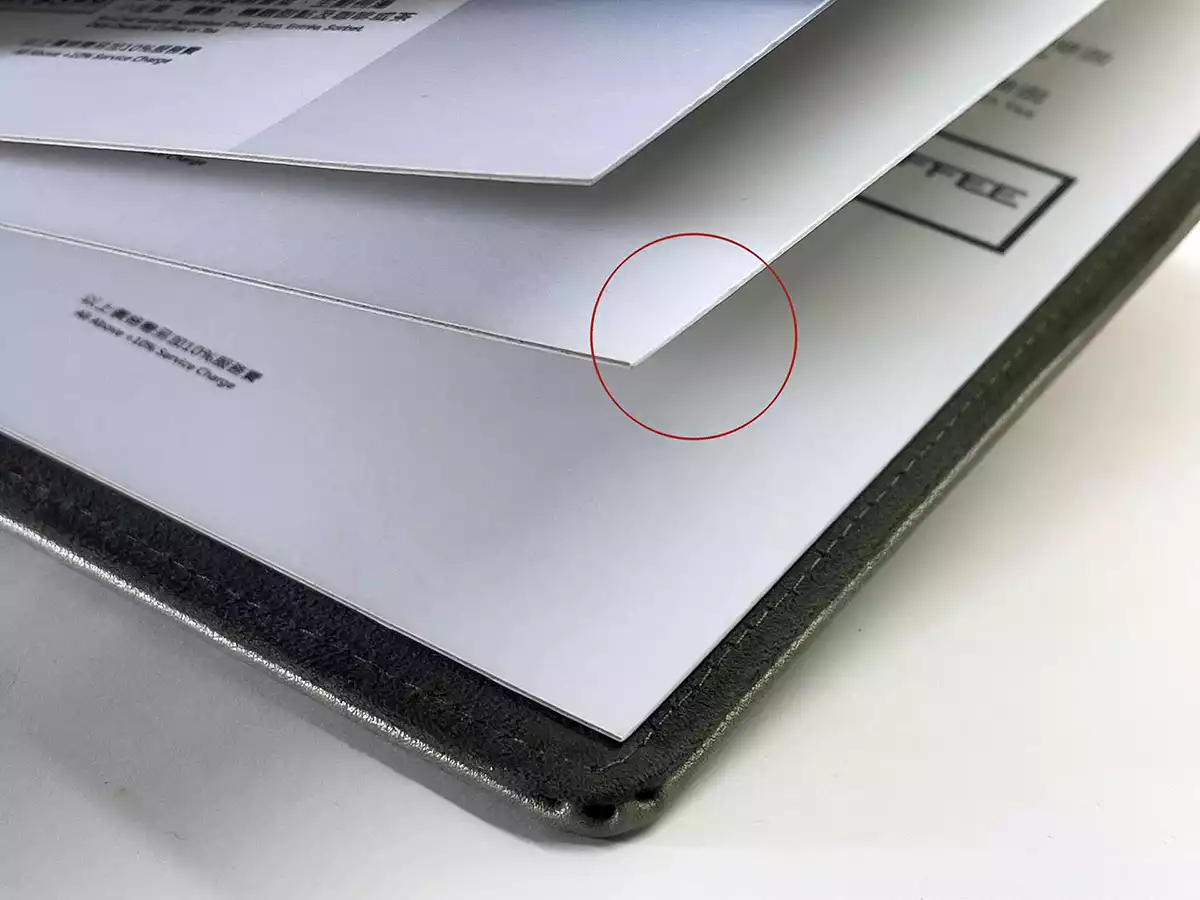
Cardboard inner pages
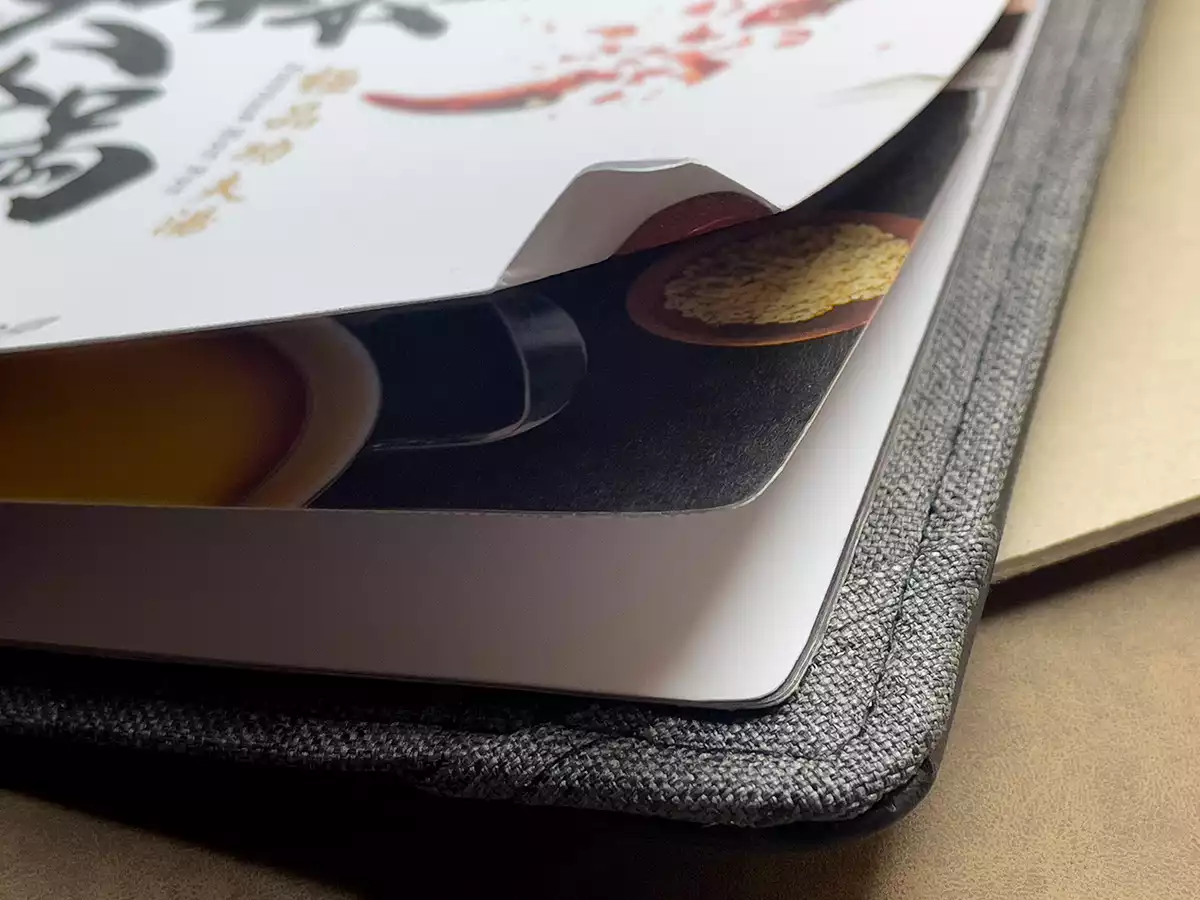
General Sika paper inner page

The information is for verification, please pay attention to the Taiwan service time difference
Weekday service hours:
Morning AM09:00~12:00 Afternoon PM01:30~06:00
Please make an appointment for a visit
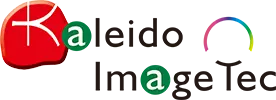
No.183, Yongle St., Xinzhuang Dist., New Taipei City 24245, (ROC)
Formosa Taiwan
Physical Verification of the Landline TEL:+886 2 2279-5252
Once, a voice had to make its way through copper wires and a spinning dial before it could land far away. Today, with just a gentle tap, our voices pirouette at our fingertips and soar away. Nowadays mobile calls glide across the airwaves free of charge. LINE and Facebook too let our chats dance across worlds without boundaries
Mini Tsai| +886 0939-113-107
Artist | +886 0919-278-778
If we ever brush shoulders in the city’s sweltering heat If by chance I miss your message, please forgive me. Through the groups below, let creativity and inspiration find each other once more:

MEMU™ Facebook page
It may take 36 hours to reply due to Taiwan time difference, Facebook fan page does not have online transaction function, Do not provide quotation or anything about money, Only for technical assistance or answer questions after transaction.
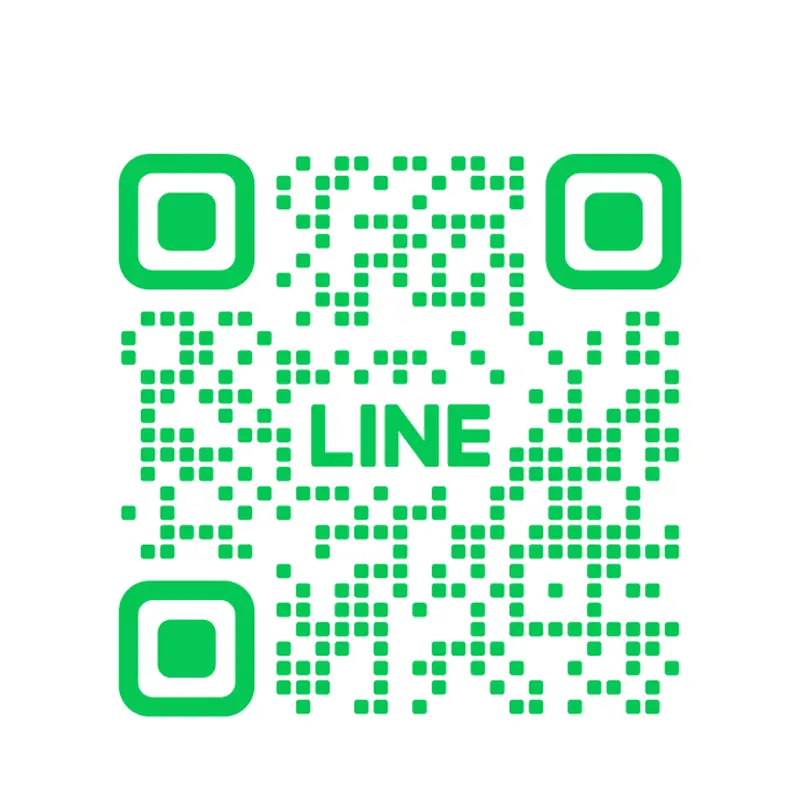
LINE Official Account
You can reach us through LINE. Or click here
Due to Taiwan’s time difference, responses may take up to 36 hours.
Our MEMU™ store is set up on LINE — you’re welcome to visit and shop.
Open the LINE app on your mobile and scan the QR code to start a chat.
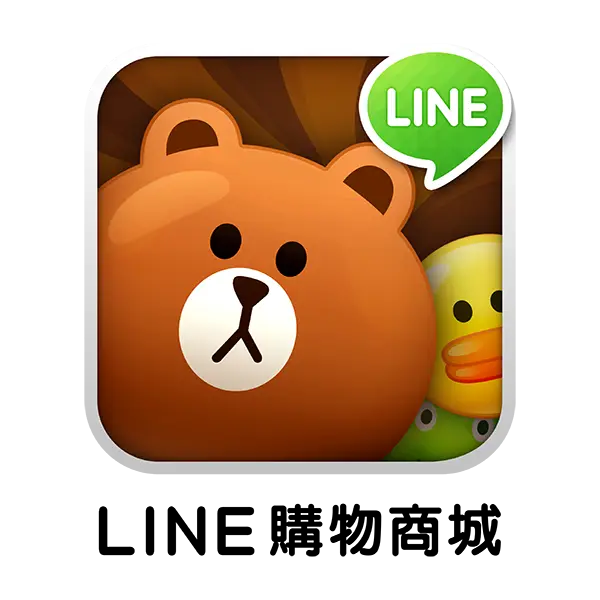
LINE Shopping Mall
MEMU™ is the only external LINE shopping mall.
Through LINE Pay / E.SUN Bank payment gateway.
Enjoy online credit card payments and online credit card installment services.
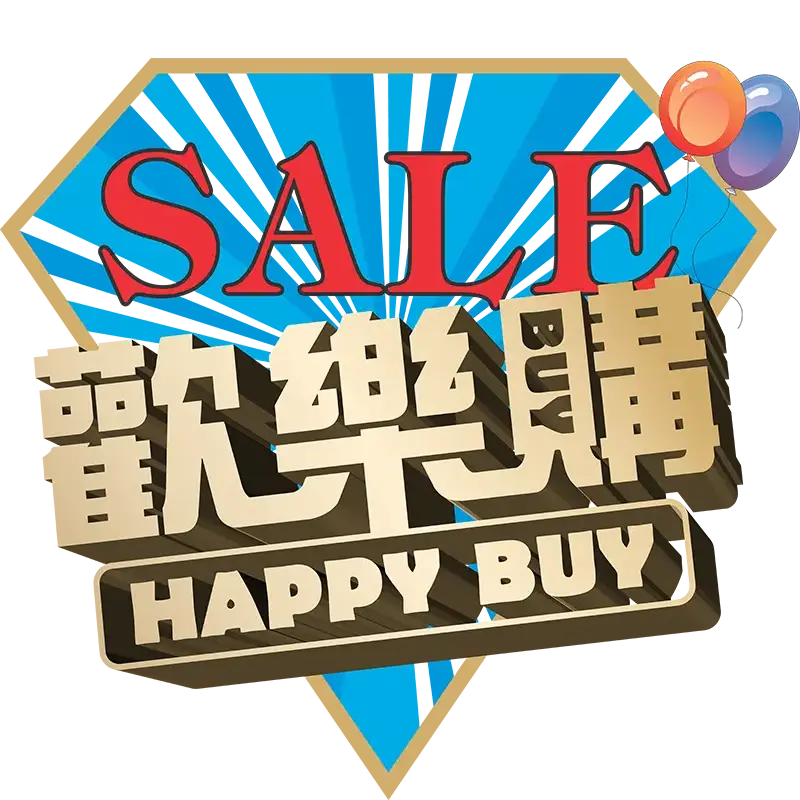
HAPPY BUY™
In-house online quoting service - Happy Buy™.
Online quoting only, no online transaction capabilities.
Both buyers and sellers need to transact through a bank.

